Remembering the Korean War, 60 years ago
This Friday, June 25th, it will have been sixty years since the beginning of the Korean War in 1950. After decades of Japanese occupation, Korea was divided in two by Allied Forces at the end of World War II, with the south administered by the U.S. and the north by Soviet Russia. Deep divisions built over several years, leading to skirmishes and finally an invasion by North Korean troops on June 25th, 1950. The United Nations sent troops and support from 21 countries to support South Korea, primarily from the United States and Britain. The war lasted for three years, with large advances and retreats on both sides, and many casualties. Hundreds of thousands of civilians and soldiers were killed. The two Koreas are technically still at war since hostilities ended in a ceasefire, not a peace treaty in 1953. Though it is often referred to as "The Forgotten War", I hope this collection of photographs helps us to remember the events of 1950-53, those involved, and the legacy that still remains, sixty years later. (48 photos total)
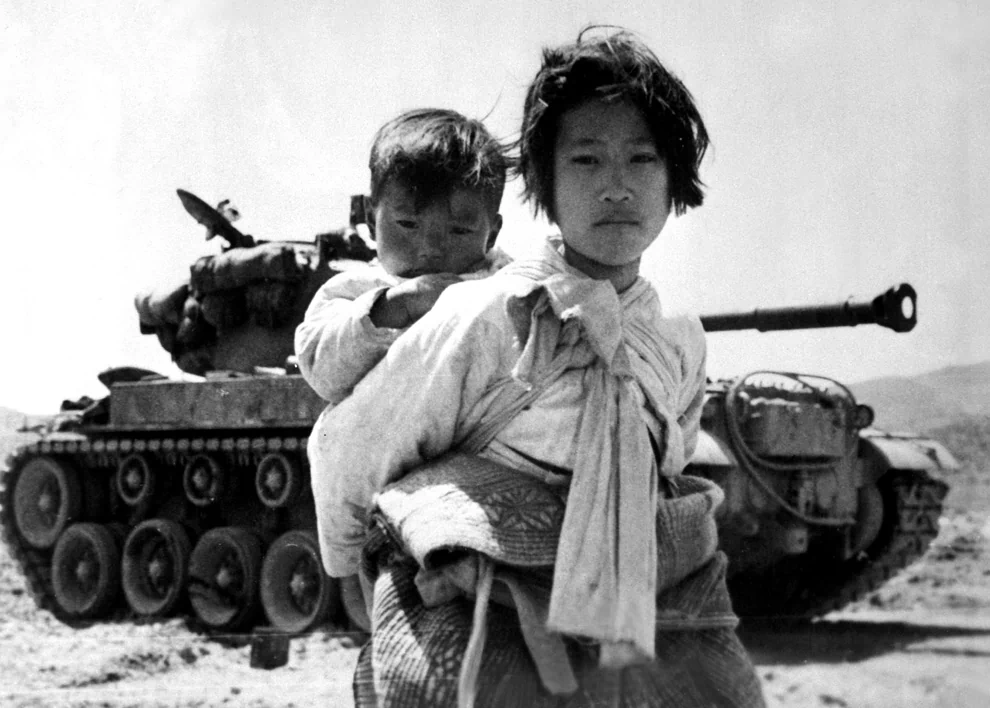
With her brother on her back a war weary Korean girl tiredly trudges by a stalled M-26 tank, at Haengju, Korea. June 9, 1951. (U.S. Navy/Maj. R.V. Spencer, UAF)
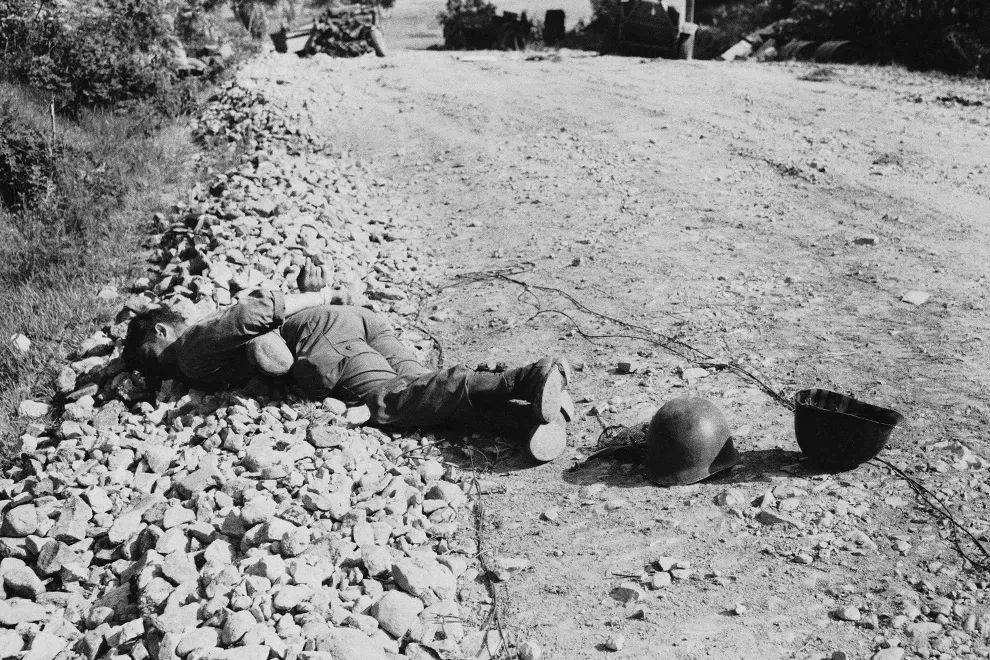
2
One of four American soldiers of the 21st Infantry Regiment, 24th Division, Company, unknown, found midway between the forward observation post and the actual front line on July 10, 1950. The cameraman's caption states that the men were probably captured the night of 9th July, and then shot. Most of them were shot through the head with their hands tied behind their backs. Along with them was a variety of Equipment burned and destroyed. (AP Photo) #
1950年7月10日,在前線和哨崗之間攝影師發現了某連24師21步兵團的4名美國士兵。照片中是4名之一,看來他是7月9日晚上遭槍擊的。頭部中彈時他們大都雙手反綁身後,攜帶的許多儀器也被燒毀了。(美聯社照片)
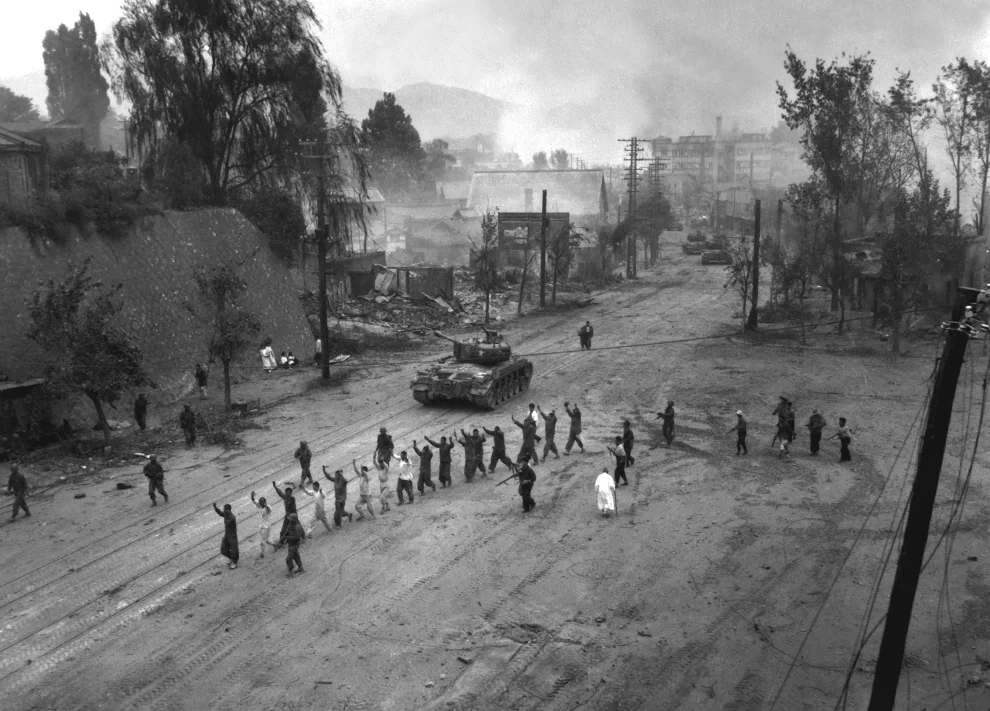
3
A U.S. Marine tank follows a line of prisoners of war down a village street. September 26, 1950. (U.S. Department of Defense/U.S. Marine Corps/S. Sgt. John Babyak, Jr.) #
1950年9月26日,一輛美國海軍陸戰隊的坦克在鄉間小路上緊隨一隊戰俘。(美國國防部/ 美國海軍陸戰隊/ 陸軍上士 John Babyak, Jr.)
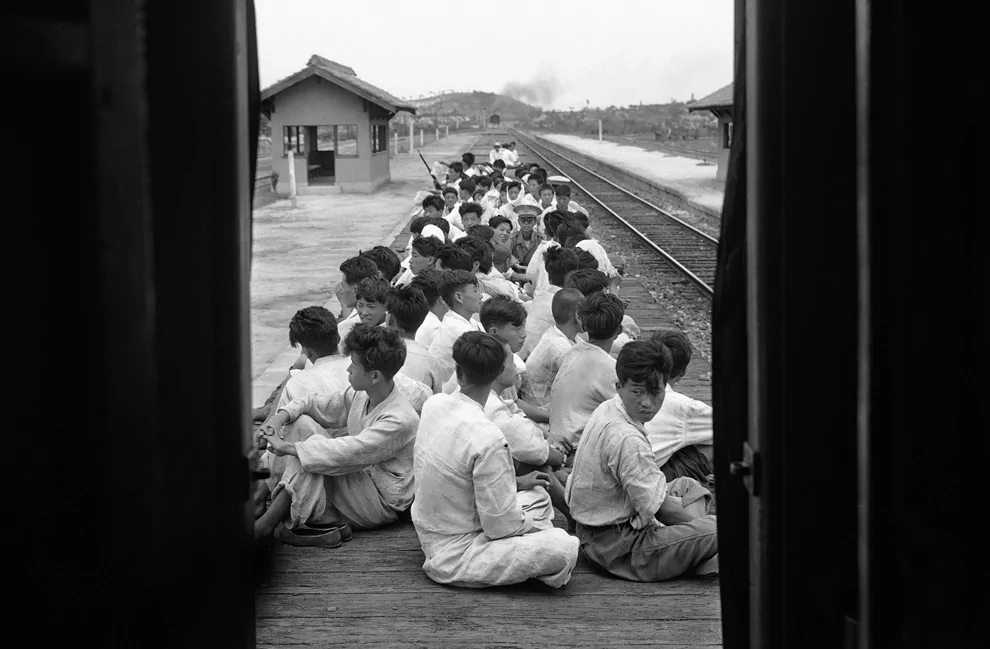
4
These South Korean recruits, sitting flat car for transfer to a training center, are heading for the army and the war against the North Korean invaders. They were given a flag-waving, band-playing send-off on July 17, 1950. (AP Photo) #
1950年7月17日,圖中的南韓應徵者坐着平板車前去訓練營,準備加入對抗北韓的戰鬥中。他們離別時,人們曾搖旗奏樂夾道相送。(美聯社照片)

5
A Bell evacuation helicopter of Marine Observation Squadron 6, carrying wounded Marines from the front lines, lands at "A" Medical Company of the First Marine Division in 1950. Naval corpsmen stand by with stretcher to unload the wounded men from helicopter "pods" and rush them to the operating and hospital tents in the background. (U.S. Department of Defense/TSGT. Charles B. Tyler) #
1950年,一架海洋觀察6中隊的BELL直升機載着傷員,降落在第一陸戰師的醫務連附近。機旁手抬擔架的是海軍團的軍人,他們趕來將傷員從直升飛機轉移到手術台上和旁邊的醫療帳篷中。(美國國防部/ 技術軍士TSGT. Charles B. Tyler)
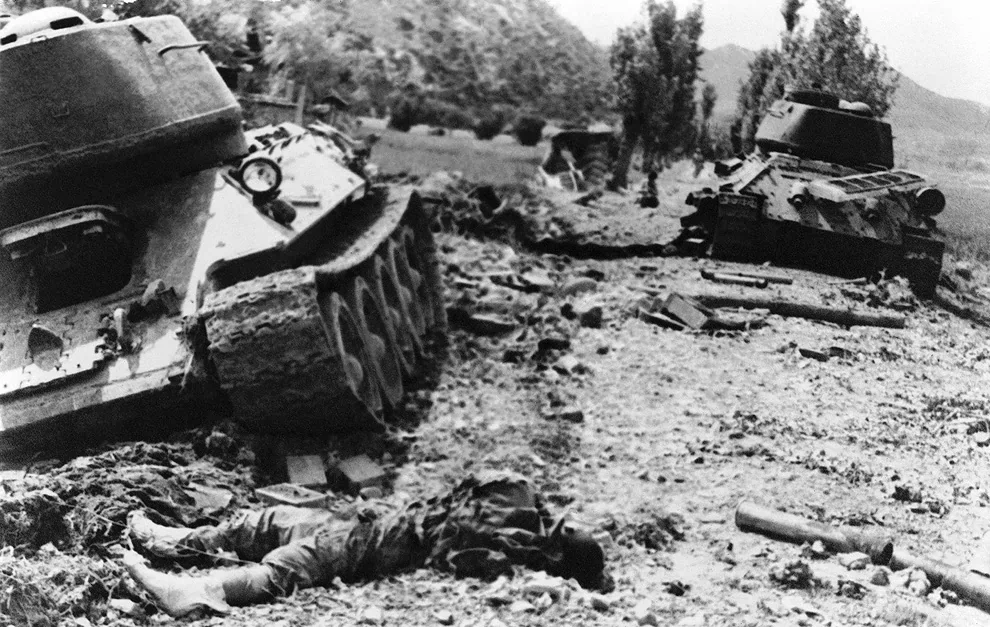
6
A North Korean tankman lies dead on ground (lower left) amid knocked-out tanks on August 13, 1950 in Indong, Korea, North of Waegwan, after South Korean attack. (AP Photo) #
1950年8月13日,在北倭館的仁同(Indong, Korea, North of Waegwan),南韓攻擊後,一片慘敗的坦克旁躺着陣亡的北朝戰士。(美聯社照片)
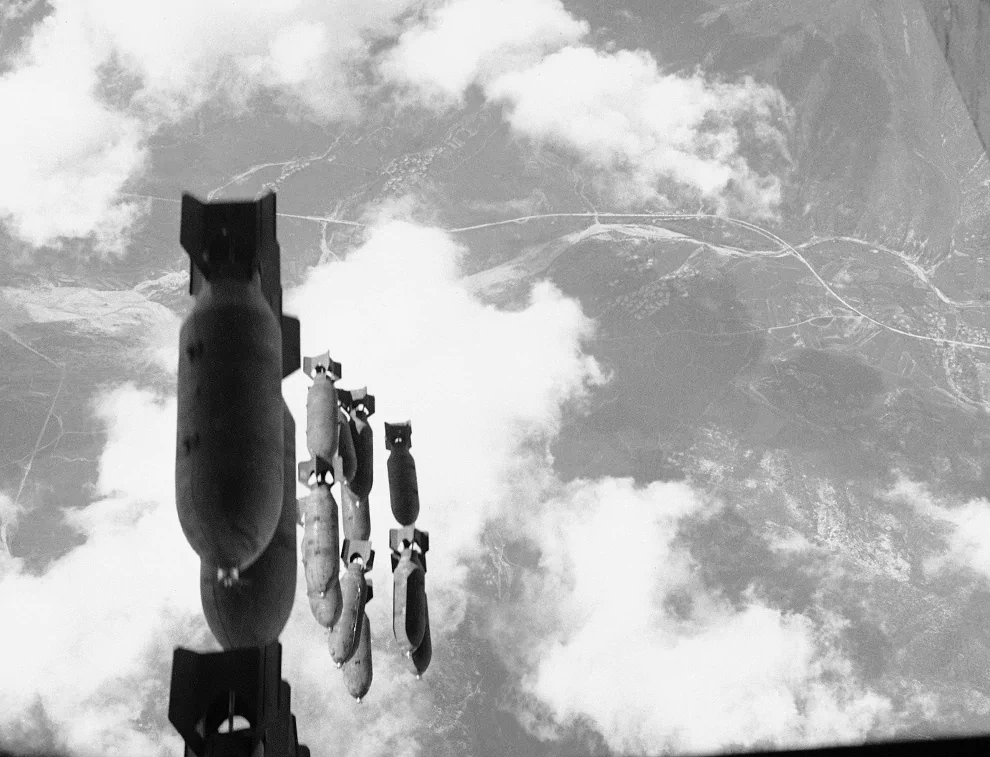
7
A salvo of 500-pound bombs leave the bomb bay of a B-29 headed for communist-controlled territory below. The first bombs from the first squadron over a 21 sq. mile area west of the Naktong River, South Korea on August 16, 1950 where North Korean troops were believed massing for an all-out assault on the American lines. 98 B-29's dropped more than 850 tons of bombs on the area. (AP Photo) #
1950年8月16日,重達500磅的炸彈離開B-29的彈倉,前往蘇聯佔據的領土。頭一個中隊投下的第一批炸彈覆蓋了南韓洛東江以西21平方哩的面積。據稱北朝軍隊駐紮此處,準備對美發起全面進攻。98架B-29共投下850噸炸彈。(美聯社照片)
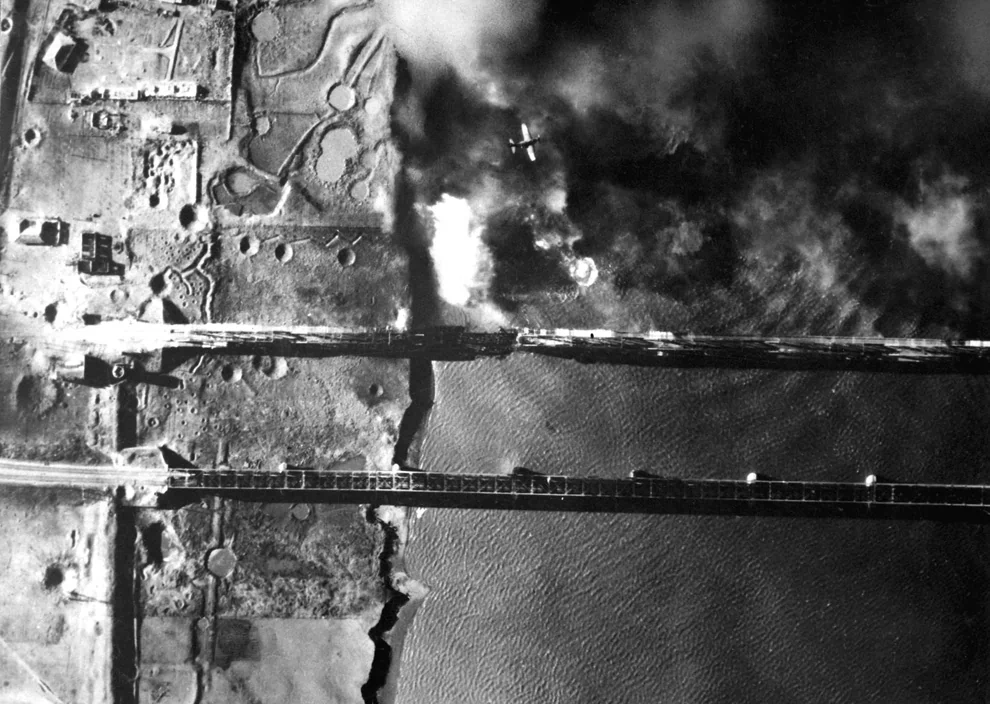
8
Navy AD-3 dive bomber (top center) pulls out of dive after dropping a 2,000 lb. bomb on Korean side of a bridge crossing the Yalu River at Sinuiju, into Manchuria on November 15th, 1950. (U.S. Department of Defense/U.S. Navy) #
1950年11月15日,在新義州---安東(中國城市)鴨綠江的一座橋上空,海軍戰機俯衝轟炸機AD-3(圖中上)在朝鮮一側投下2000英鎊炸彈後拉起。(美國國防部/ 美國海軍)
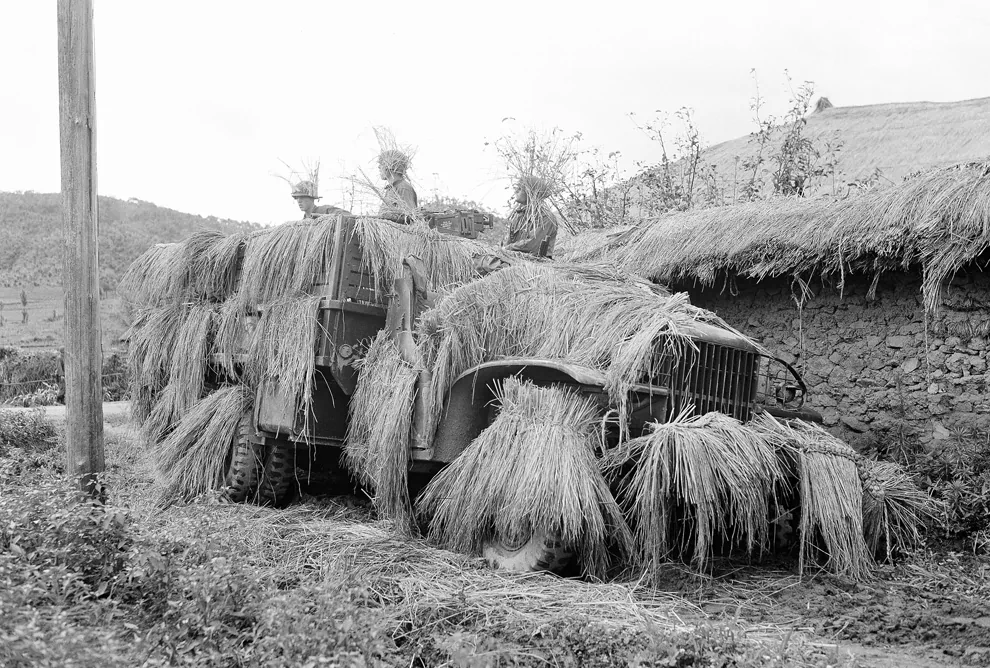
9
This view shows a command post somewhere in South Korea on July 12, 1950 as American soldiers keep on the alert with their straw-covered camouflaged weapons carrier. (AP Photo/Charles P. Gorry) #
1950年7月12日,位於南韓的某指揮所。照片中美國士兵在稻草的掩護下仍保持着警戒狀態。(美聯社照片/ Charles P. Gorry)
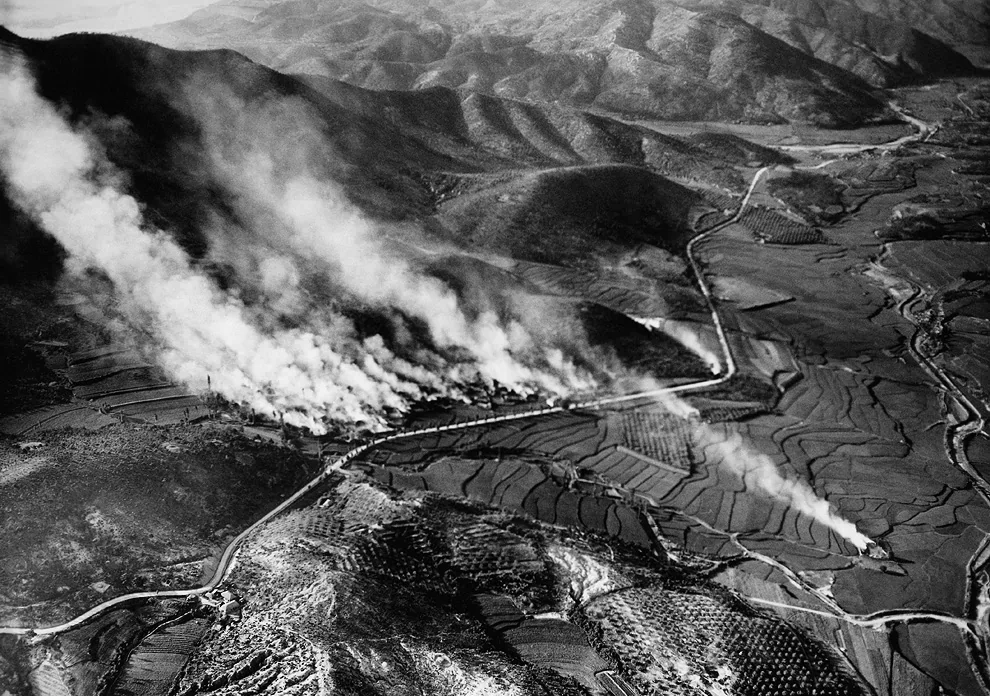
10
Smoke rises from the ruins of the village of Agok the northern region of South Korea in August 1950. (AP Photo/Max Desfor) #
1950年,從南韓北部Agok村莊的廢墟上,濃煙升起。(美聯社照片/ Max Desfor)
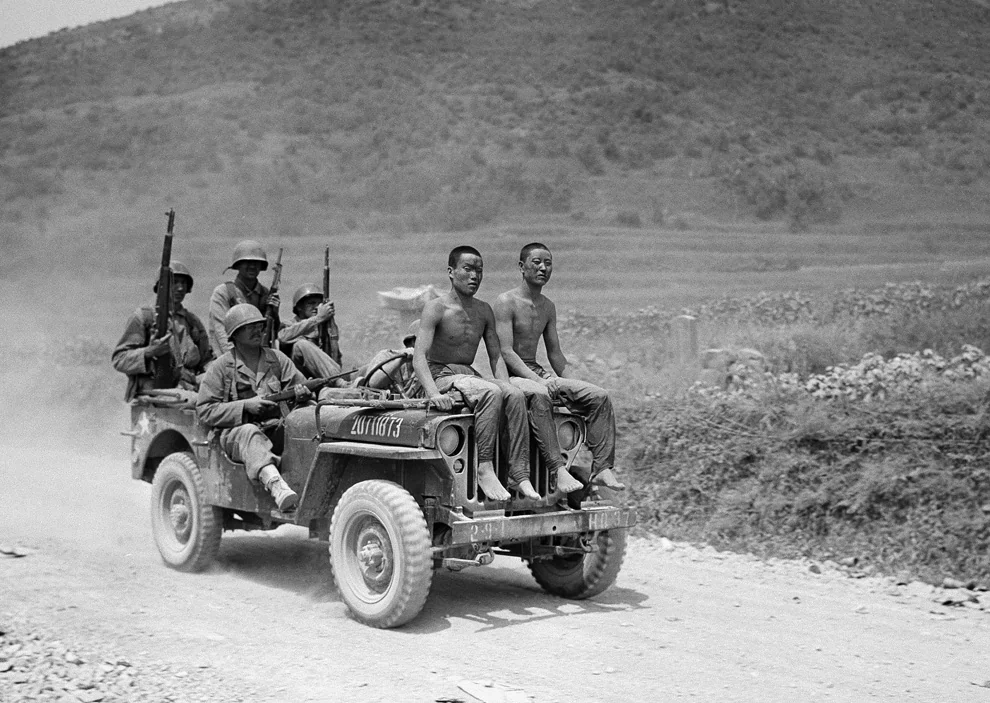
11
Two North Korean prisoners captured during fighting for Yongsan on September 2, 1950 sit on jeep hood under guard of U.S. second division infantrymen as they are taken to the rear in the Naktong River sector of Korea. (AP Photo) #

Warning:
This image contains graphic
or objectionable content
click here to view it.
12
This U.S. Army photograph, once classified "top secret", is one of a series depicting the summary execution of 1,800 South Korean political prisoners by the South Korean military at Taejon, South Korea, over three days in July 1950. Historians and survivors claim South Korean troops executed many civilians behind frontlines as U.N. forces retreated before the North Korean army in mid-1950, on suspicion that they were communist sympathizers and might collaborate with the advancing enemy. (AP Photo/National Archives, Major Abbott/U.S. Army) #
1950年7月份,在韓國大田市1800名政治犯被南韓軍隊處決的情況。史學家和倖存者們表示,在聯合國軍隊先於北韓在1950年年中撤退時,南韓軍隊處決了後方很多政治犯,因為懷疑這些人是親共派並成了自己敵人的同夥。(美聯社照片/ 美國國家檔案館,Major Abbott/ 美國陸軍)
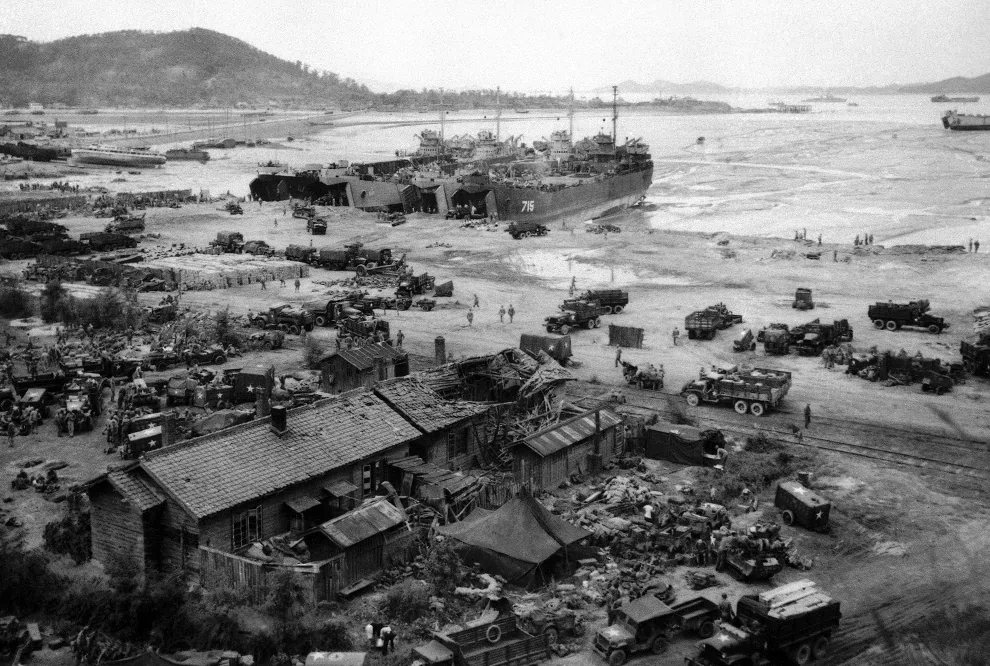
13
Four LST's unload men and equipment on beach in Inchon on Sept. 15, 1950. (AP Photo) #
1950年9月15日,在仁川市的海灘上4輛登陸艦正在卸載士兵和設備。(美聯社照片)
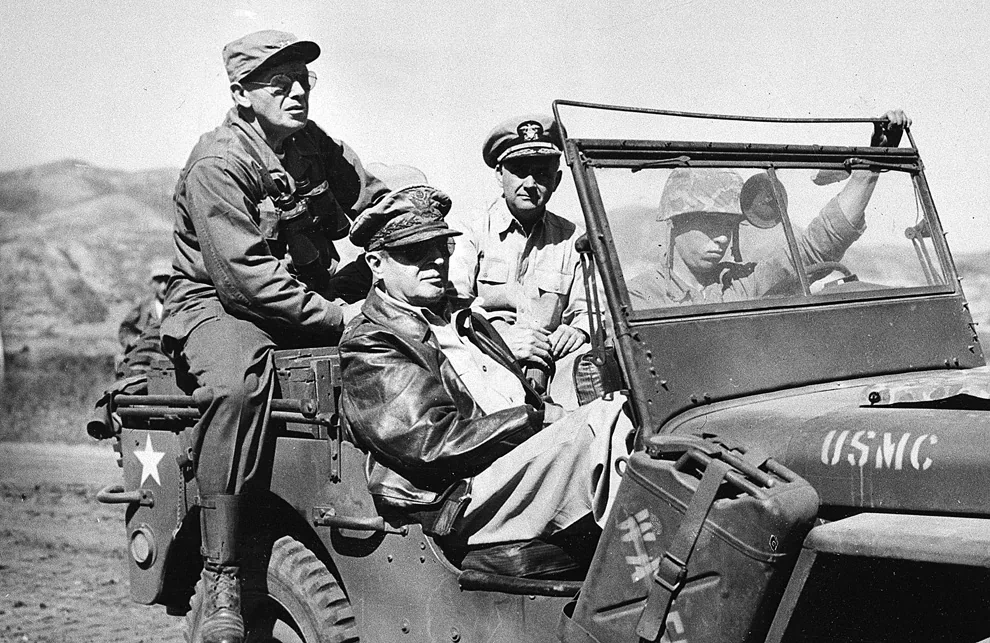
14
General Douglas MacArthur, in passenger seat wearing leather jacket, tours the newly opened Inchon Front in Western Korea on Sept. 19, 1950 during the Korean War. Accompanying him are, Maj. Gen. Edward M. Almond, left, Tenth Corps Commander, and Vice Adm. Arthur D. Struble, Fifth Fleet Commander. (AP Photo/U.S. Army Signal Corps) #
1950年9月19日,在朝鮮半島西部仁川,麥克阿瑟將軍身着皮衣,巡視新拉起的戰線。陪同他的是第十軍團司令、少將Edward M. Almond(圖左)、第五艦隊司令、中將. Arthur D. Struble。 (美聯社/ 美軍錄用通信兵)
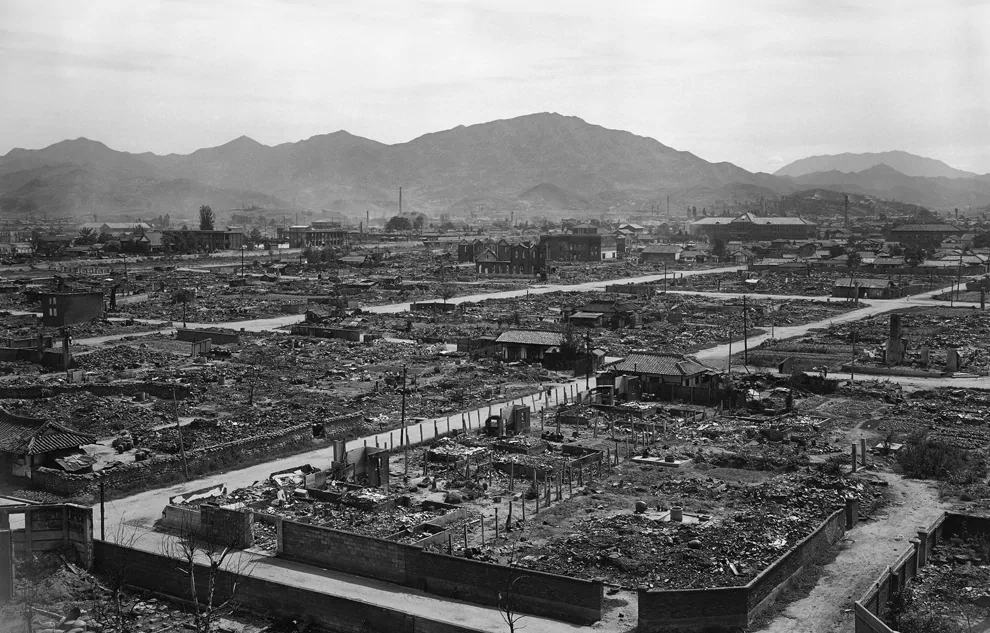
15
General views of burned city of Taejon on Sept. 30, 1950. (AP Photo/Jim Pringle) #
1950年9月30日,韓國大田,灰燼之城鳥瞰。(美聯社/ Jim Pringle)
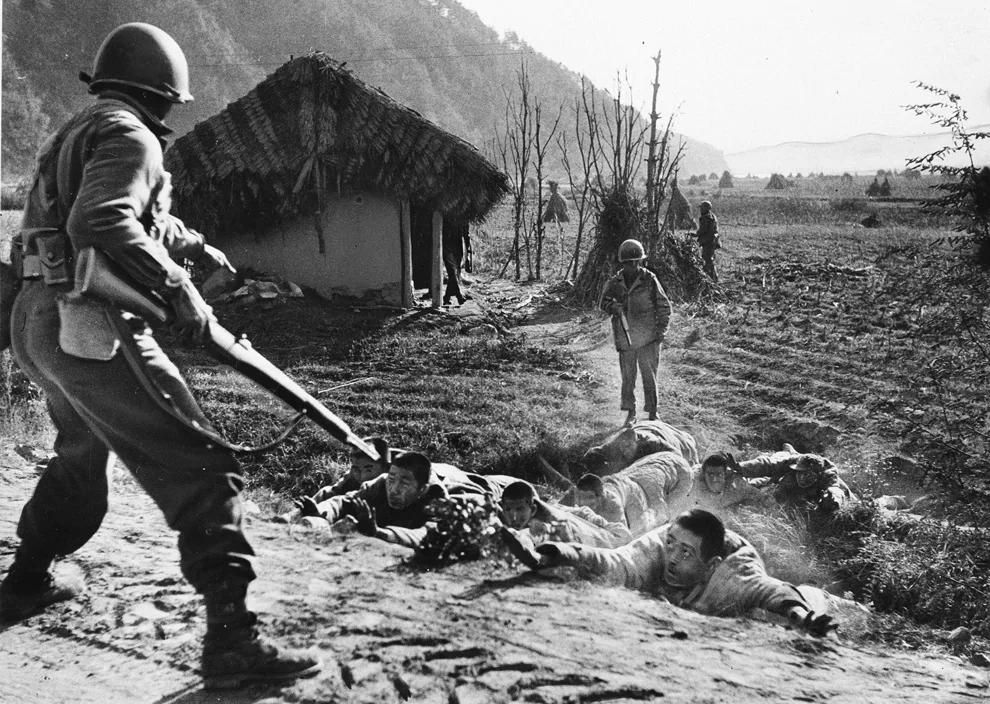
16
Prisoners are flushed out by a U.S. patrol operating in North Korea south of Kusong, Nov. 16, 1950. This is a Life Magazine Photo by Hank Walker. (AP Photo/Hank Walker) #
1950年11月6日,在北韓龜城南部,美國巡邏兵將一批俘虜拖走。本照片由《生活》雜誌的Hank Walker拍攝。(美聯社照片/ Hank Walker)
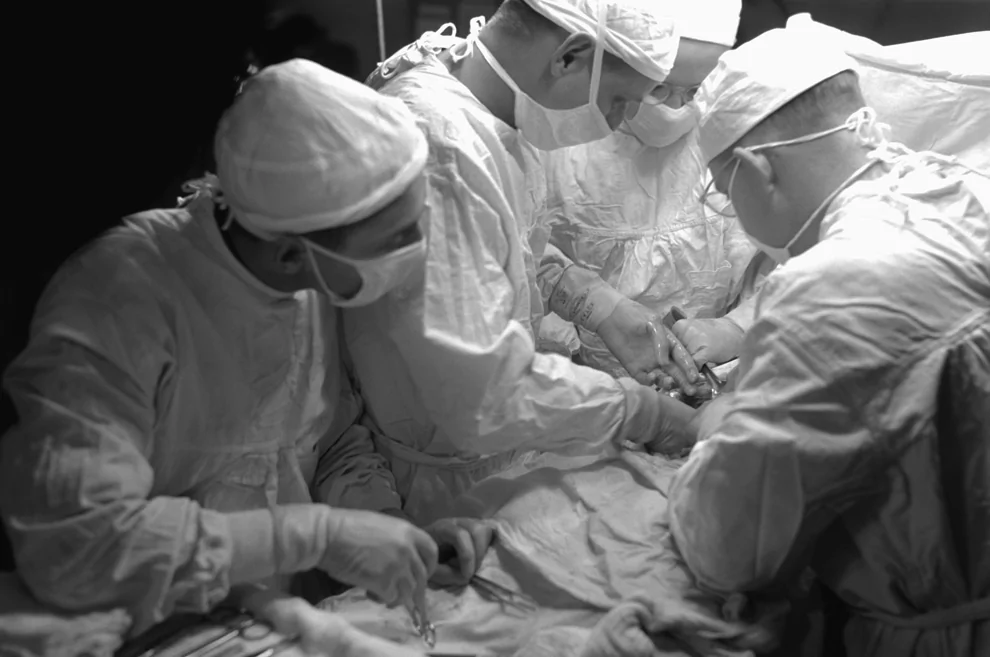
17
Doctors operate on a Marine wounded in Korean fighting on June 25th, 1950. (U.S. Department of Defense/TSGT. Robert H. Mosier) #
1950年6月25日,美國軍醫們為在朝鮮戰場上受傷的海軍陸戰隊士兵做手術。(美國國防部/ 上士Robert H. Mosier)
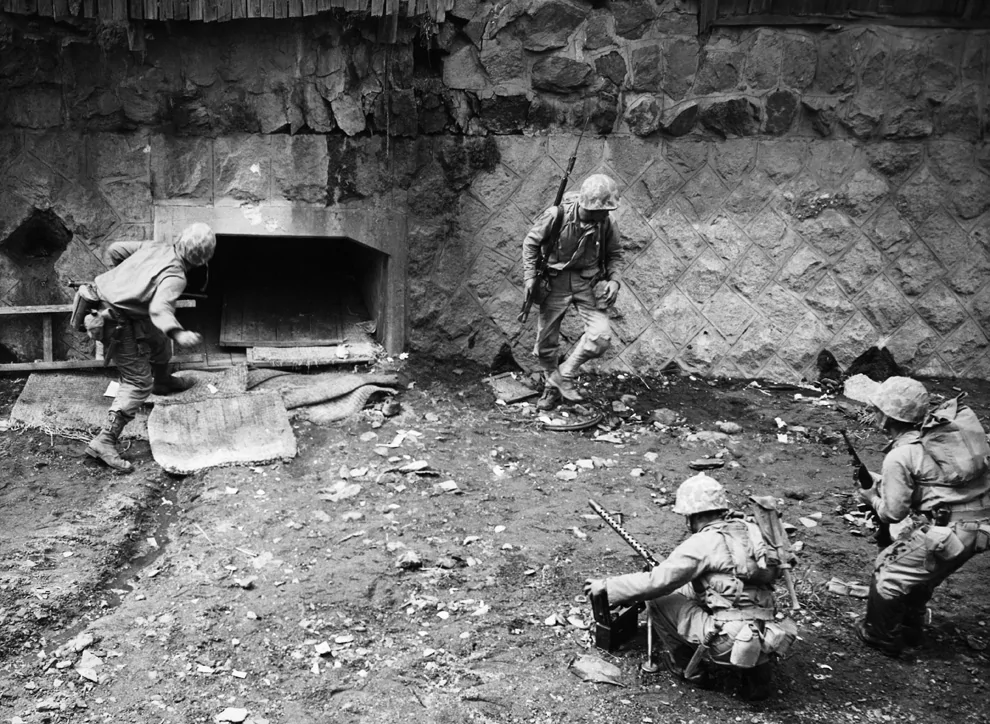
18
After civilians reported that North Koreans had taken cover inside, a U.S. Marine throws a grenade into a Seoul tunnel, in September 1950. A machine gunner and rifleman cover the cave entrance. (AP Photo/Max Desfor) #
1950年9月,漢城。通過市民得知隧道被北朝軍隊佔領後,美國兵投進去一顆手榴彈。機槍手和步槍手瞄準了洞穴入口。(美聯社照片/ Max Desfor)
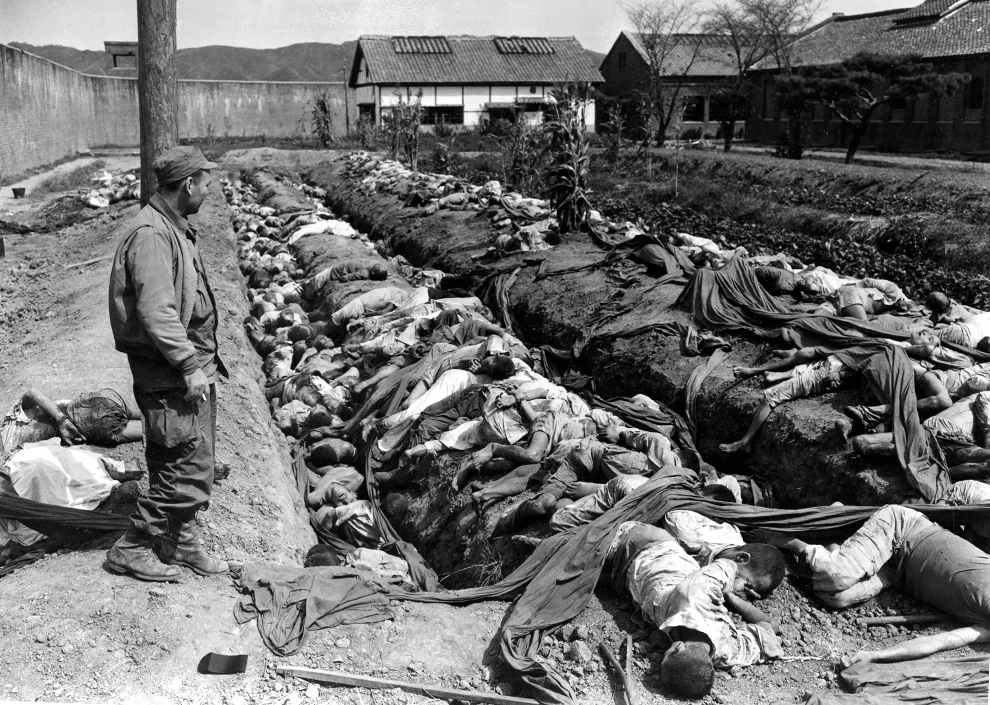
Warning:
This image contains graphic
or objectionable content
click here to view it.
19
Bodies of some 400 Korean civilians lie in and around trenches in Taejon's prison yard during the Korean War in Sept. 1950. The victims were bound and slain by retreating Communist forces before the 24th U.S. Division troops recaptured the city Sept. 28. Witnesses said that the prisoners were forced to dig their own trench graves before the slaughter. Looking on, at left, is Gordon Gammack, war correspondent of the Des Moines Register and Tribune. (AP Photo/James Pringle) #
1950年9月,在韓國大田市監獄內一條壕溝里,橫着約400具韓國人的屍體。在美國軍隊24號重新拿下大田時之前,撤退中的北朝軍隊囚禁並殺害了這些人。目擊者說,囚犯們在死前要自掘墳墓。照片中左邊的是《狄盟註冊報》(the Des Moines Register and Tribune)的戰地記者Gordon Gammack。(美聯社照片/ James Pringle)
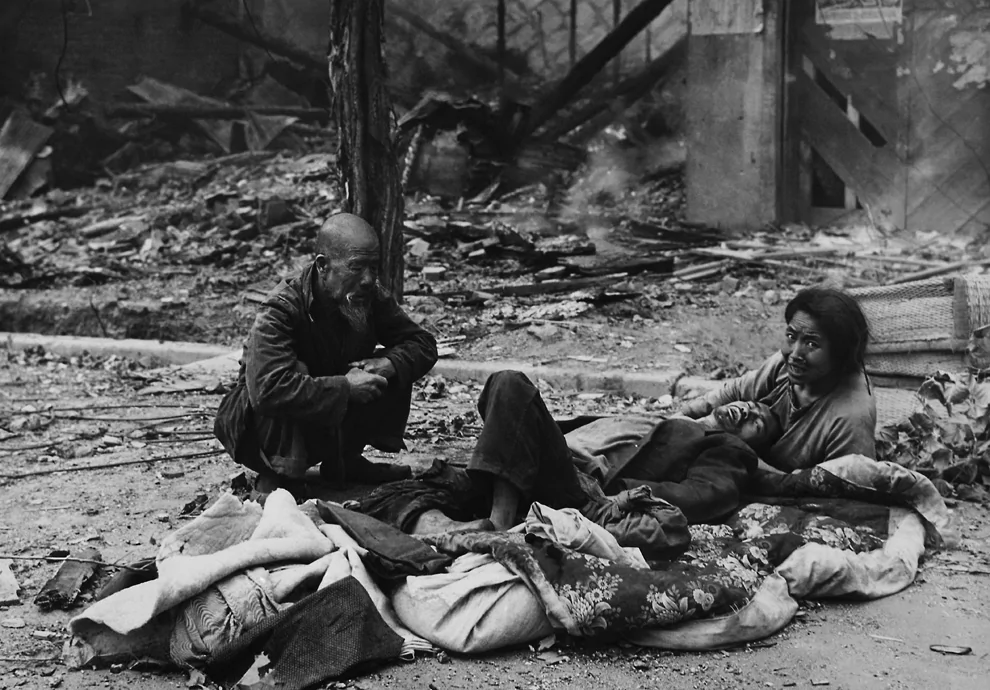
20
Koreans huddle in the street amid rubble and debris after fighting in Seoul, September 1950. (AP Photo/Max Desfor) #
1950年9月,漢城,民眾蜷身於戰事後的一片廢墟中。(美聯社照片/ Max Desfor)
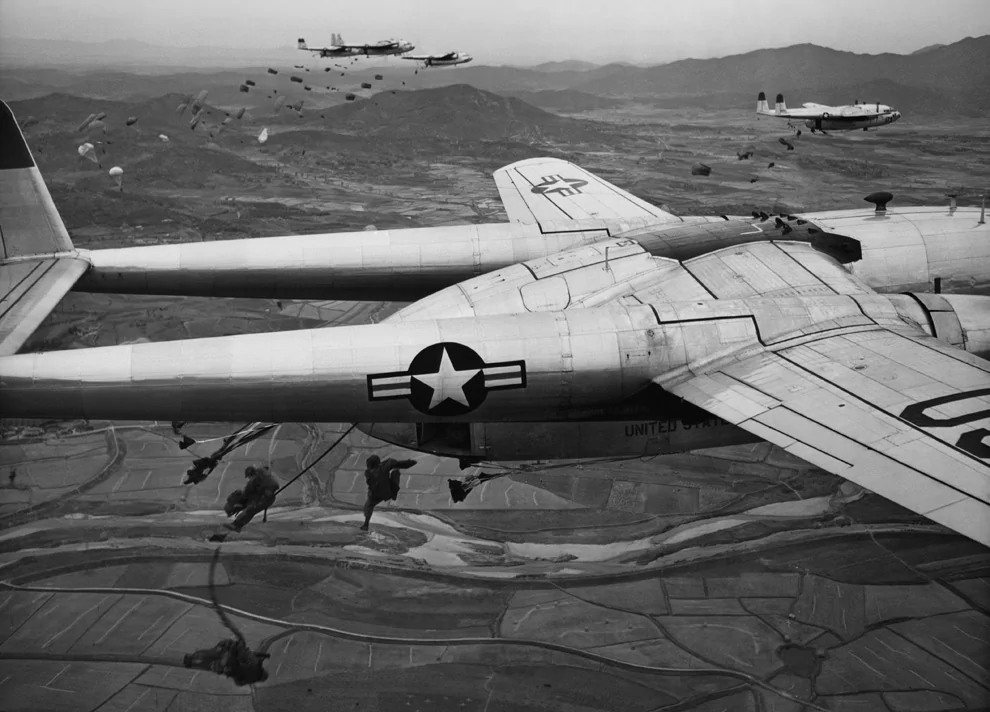
21
Paratroopers drop from U.S. Air Force C-119 transport planes during an operation over an undisclosed location in Korea, in October 1950. (AP Photo/Max Desfor) #
1950年10月,執行一項針對保密地區任務的美國傘兵從空軍C-119運輸機跳下。(美聯社照片/ Max Desfor)
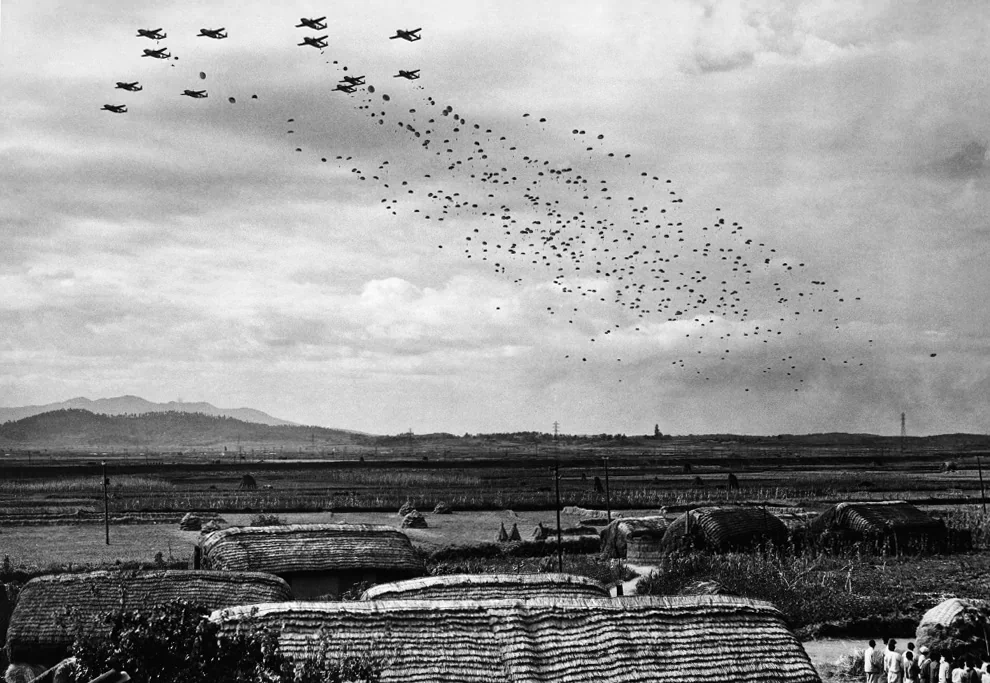
22
Paratroopers of the United Nations forces jump from aircraft near the North Korean towns of Sukchon and Sunchon, about Oct. 20, 1950. (AP Photo/Max Desfor) #
1950年10月20日左右,在北韓小鎮肅川和順天(Sukchon and Sunchon)附近,聯合國軍傘兵從天而降。(美聯社照片/ Max Desfor)
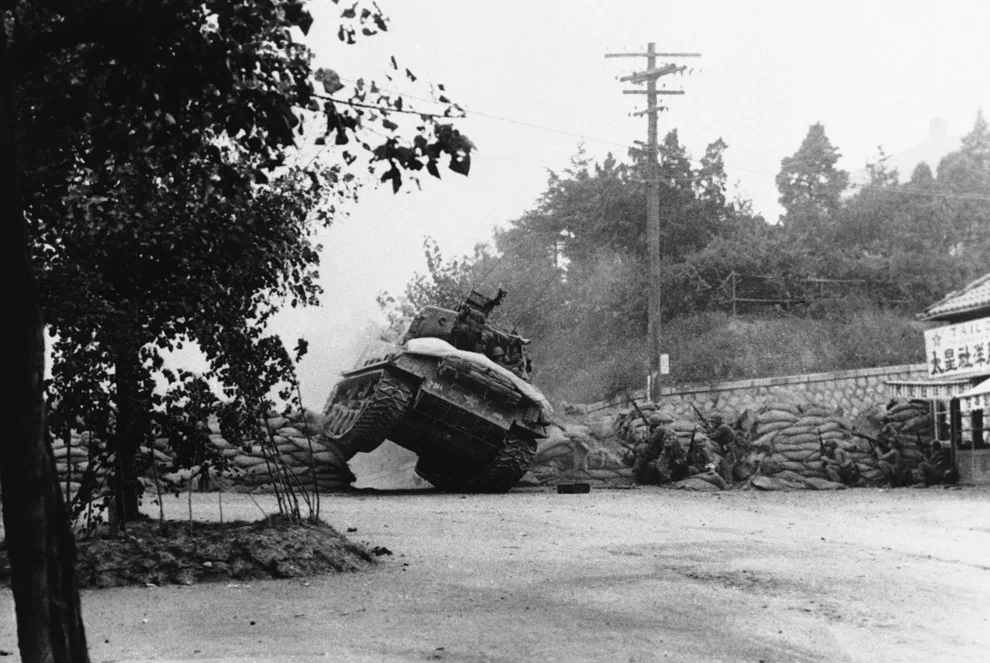
23
An American tank crashes roughshod through an enemy roadblock near Seoul, South Korea, Oct. 7, 1950, as 7th Division infantrymen prepare to exploit the breakthrough and put an end to enemy sniper fire in this sector of the Korean front. (AP Photo) #
1950年10月7日,在韓國漢城附近,美軍坦克碾過敵軍的路障。此時第7步兵師正要乘勝追擊、徹底摧毀敵方的狙擊火力。(美聯社照片)
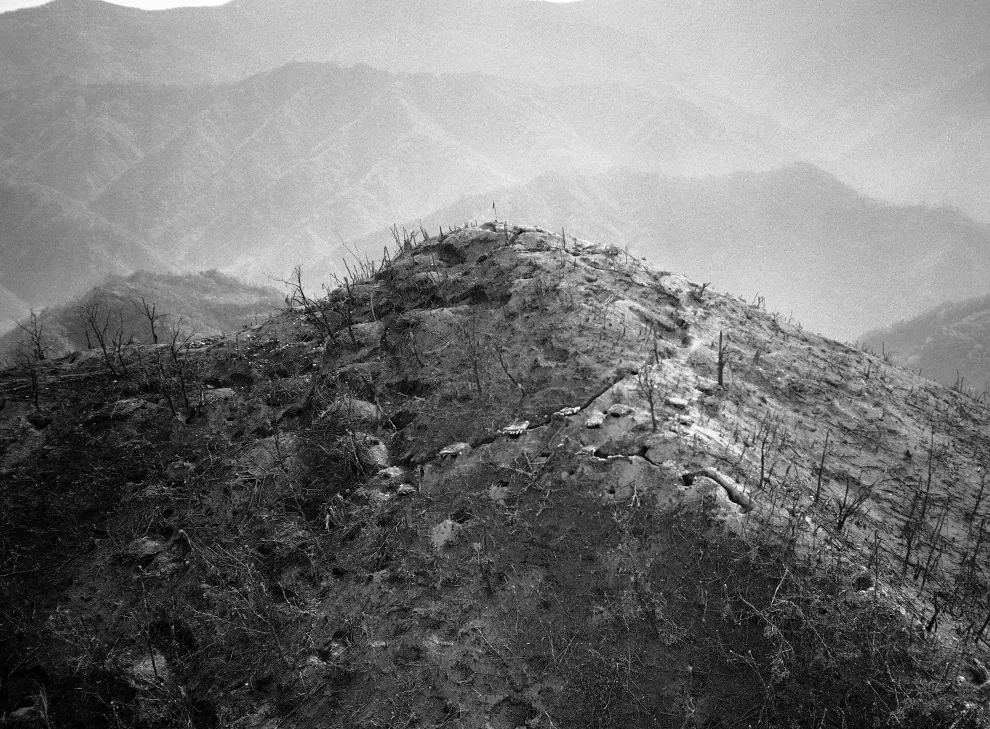
24
Trees stripped by artillery and aerial bombardment stand like match sticks in this air view of hill 931 on Oct. 22, 1950, one of the main peaks which dominated Heartbreak Ridge in Korea. The complex system of communist trenches and bunkers are visible. This hill was taken twice by U.N. forces, the last time on October 6 by elements of the 23rd U.S. Regiment and a French Battalion. (AP Photo/GS) #
1950年10月22日,一輪輪地空轟炸後,931山上的樹像一根根直立的火柴棍。這座山頭是傷心嶺戰役中幾座重要的山峰之一。北朝軍隊戰壕和碉堡的複雜體系由圖可見。美軍曾兩次佔領這座山,後一次是10月6日,協作雙方是美軍23團和法軍某營。(美聯社照片/ GS)
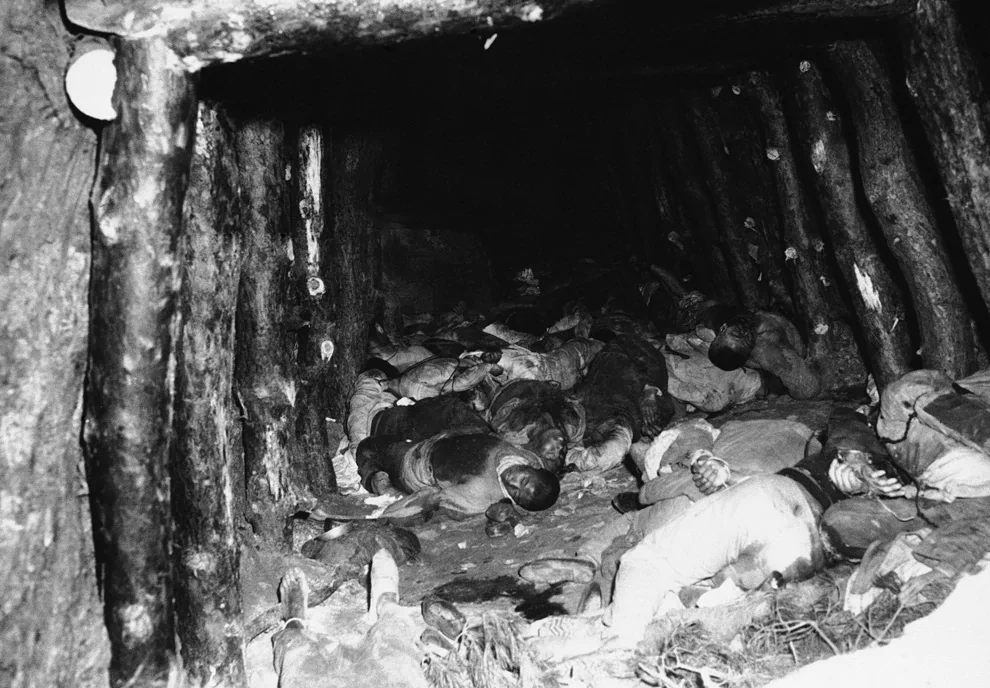
Warning:
This image contains graphic
or objectionable content
click here to view it.
25
The bodies of more than 60 South Korean civilians bludgeoned to death in a mine shaft at Kum Bong San, near Tube-ni, Korea, Oct. 19, 1950. The Army said the victims were slain by Communist led North Korean forces who took them from a prison at Chinnampo. The bodies were discovered by U.N. troops. (AP Photo) #
1950年10月19日,在朝鮮Tube-ni附近Kum Bong San的一口礦井中60多名南韓百姓被活活打死。軍方稱,對這些從鎮南浦監獄中的人下手的是共產主義陣營的北朝軍隊。這些屍體由聯合國軍隊發現。(美聯社照片)
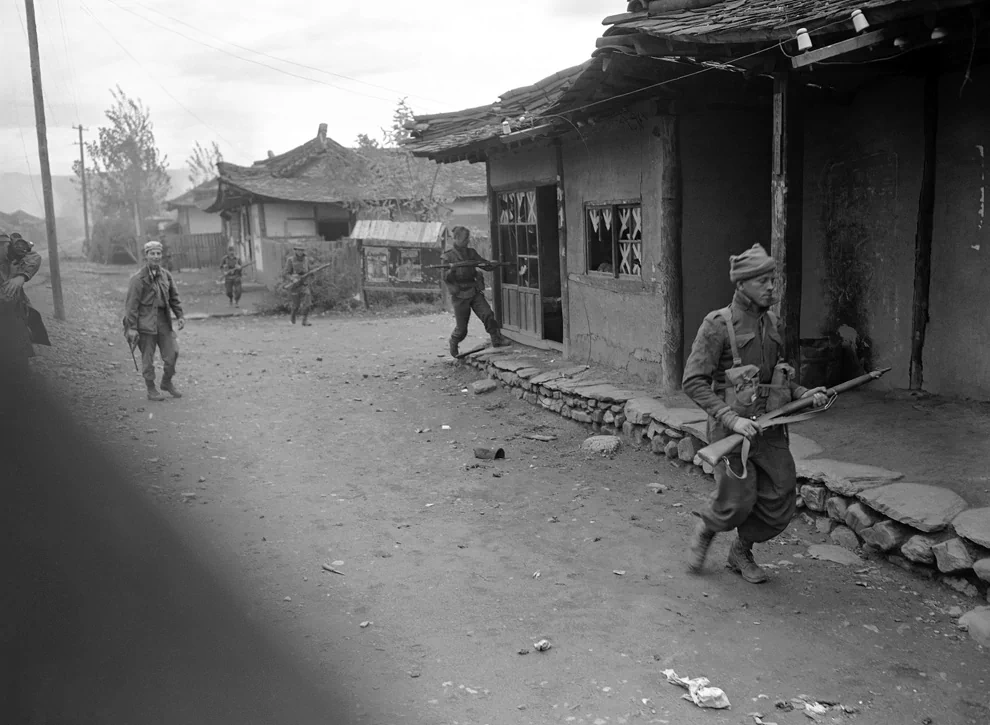
26
British and Australian troops search houses in Hwangju on Oct. 17, 1950 in mopping up operations during the drive toward Pyongyang, Capital of North Korea. (AP Photo/Max Desfor ) #
1950年10月,英國和澳大利亞士兵在韓國黃州搜查房子,他們正在前往北朝首都平壤的掃蕩活動中。(美聯社照片/ Max Desfor)
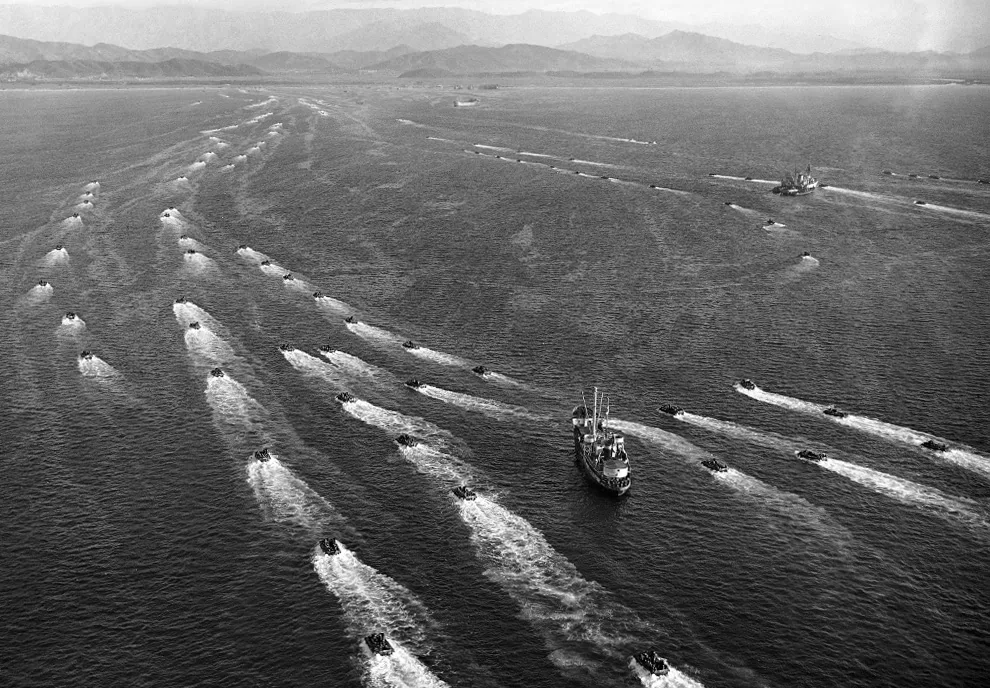
27
Landing boats loaded with U.S. soldiers speed through the mine-infested waters of Wonsan harbor toward the North Korean east coast city on Oct. 26, 1950. About 50,000 U.S. soldiers and Marines hit the beach to bolster Allied forces driving toward the Manchurian border. (AP Photo/Gene Herrick) #
1950年10月26日,滿載美國士兵的登陸艦駛過佈滿水雷的元港(Wonsan harbor)水域,去往北朝的東部沿海城市。約5萬名美海陸軍士兵登陸,增援向中國東北與北朝接壤地區開進的盟軍部隊。(美聯社/ Gene Herrick )

28
In this Dec. 4, 1950 file photo, residents from Pyongyang, North Korea, and refugees from other areas crawl perilously over shattered girders of the city's bridge, as they flee south across the Taedong River to escape the advance of Chinese Communist troops. (AP Photo/Max Desfor) #
1950年12月4日,為躲避中共軍隊,平壤居民和其他地區的難民沿着城市大橋的樑上逃往大同江那邊的南韓。(美聯社照片/ Max Desfor)
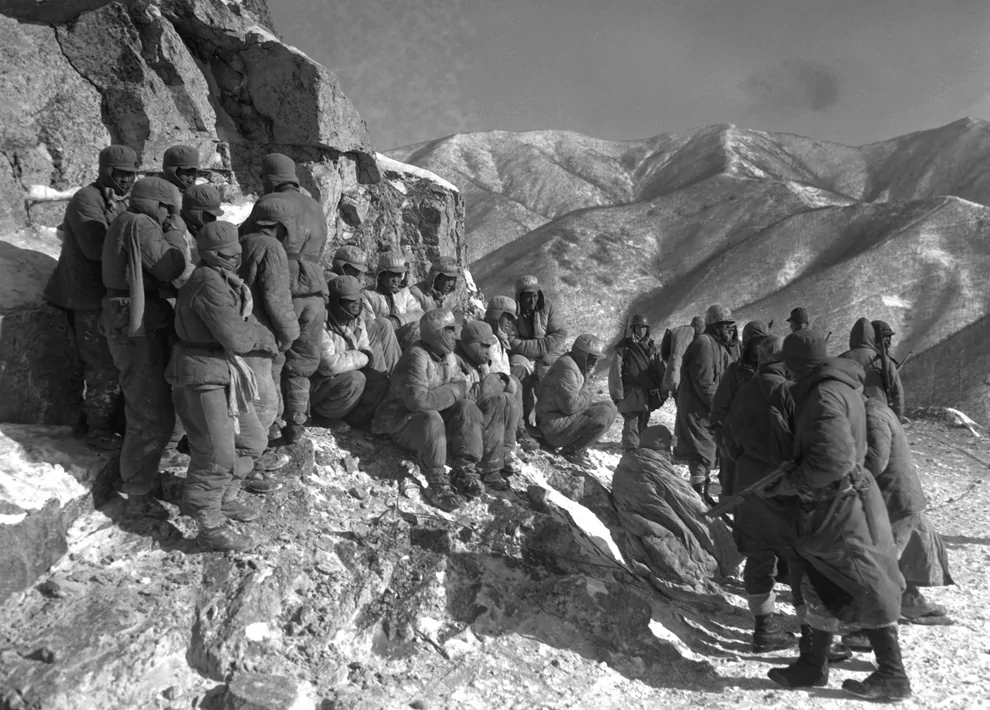
29
Chinese communist troops, wearing tennis sneakers, rags and American footgear, surrender to Charley Company, 7th Marines, south of Koto-ri, on December 9th, 1950. (U.S. Department of Defense/SGT. F.C. Kerr) #
1950年12月9日,在Koto-ri南部,中共士兵穿着網球鞋、美國鞋襪,向美軍第7海軍陸戰隊查理連投降。(美國國防部/ 上士 F.C.Kerr)
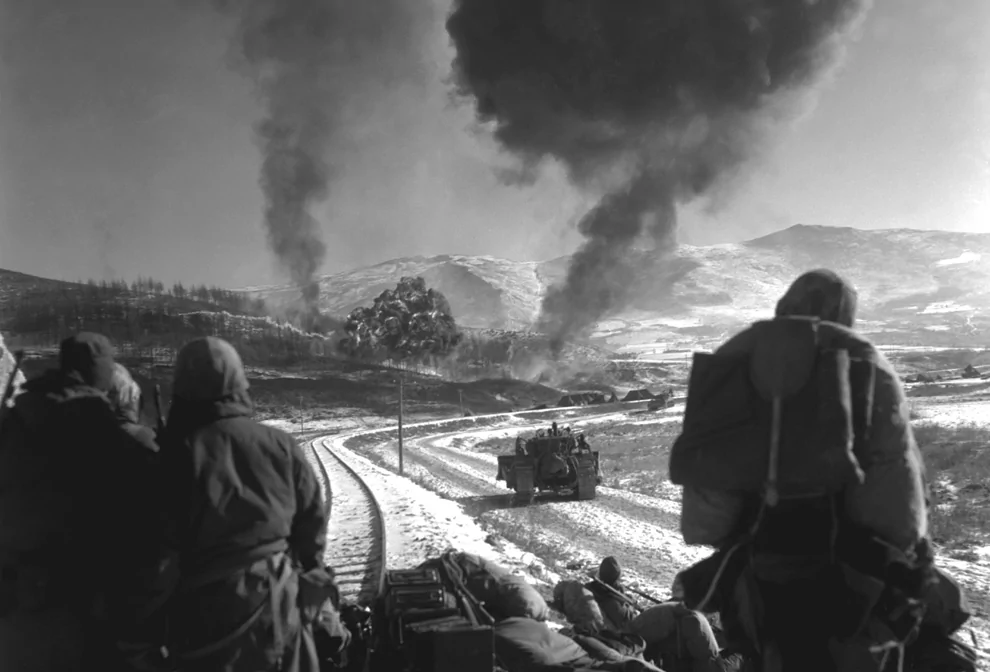
30
Close coordination of the United States Marine air and ground units during recent fighting with Chinese Communists in Korea. United States Marines drive forward after effective close air support of F4U-5 Corsairs on December 26th, 1950. (U.S. Department of Defense/CPL. P. McDonald) #
1950年12月26日,在最近的一場對中共軍隊作戰中,美地空部隊密切協調。海軍陸戰隊在F4U-5海盜式戰鬥機的有效支援後繼續將戰線向前推進。(美國國防部/ 下士 P. McDonald)
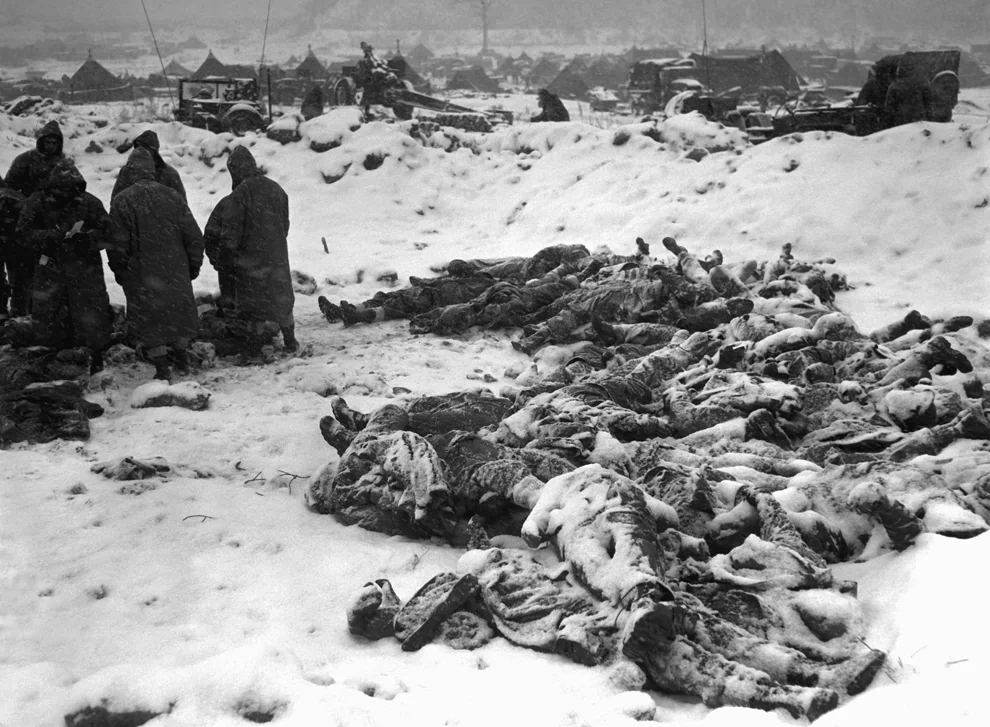
Warning:
This image contains graphic
or objectionable content
click here to view it.
31
Bodies of U.S. Marines, British Royal Marines Soldiers and Republic of Korea troops are gathered for a mass burial at Koto-ri on December 8th, 1950. (U.S. Department of Defense/SGT. F.C. Kerr) #
1950年12月8日,在Koto-ri(?里),美海軍陸戰隊、英國皇家海軍陸戰隊和韓國陣亡士兵運到一起,舉行集體葬禮。(美國國防部/ 上士 F.C. Kerr)
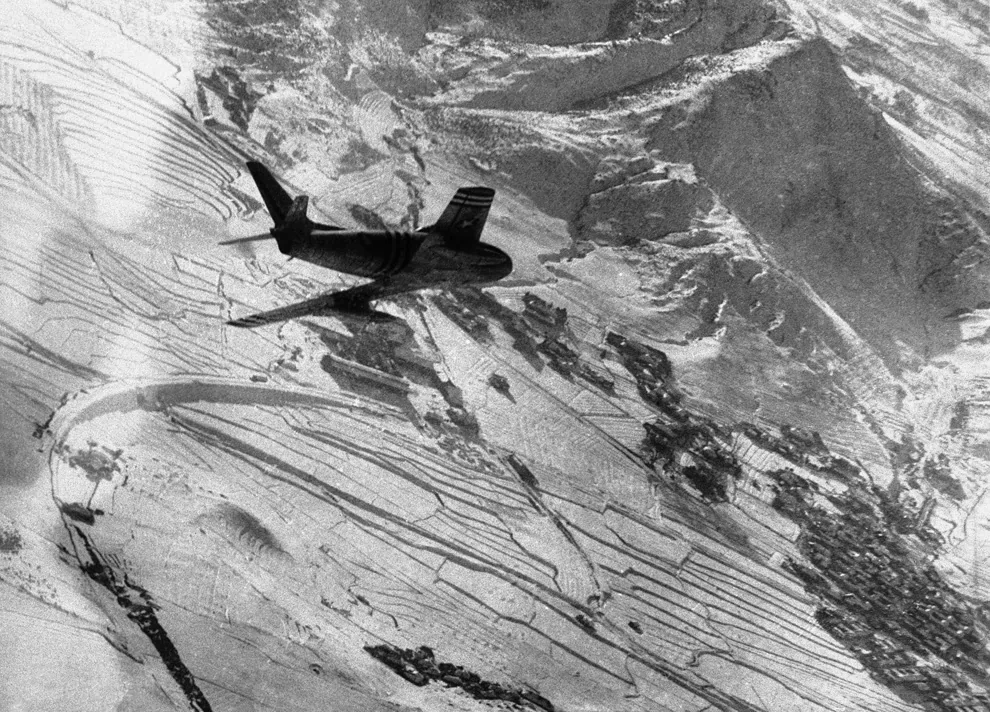
32
An F86 Sabre Jet peels off for an attack on a communist troop and supply concentration in the snow-covered Korean village below on January 28th, 1951. (AP Photo) #
1951年1月28日,一架F86軍刀噴氣式飛機投下攻擊中共軍隊的炮彈。同時它也在為大雪覆蓋的村莊提供物資。(美聯社照片)
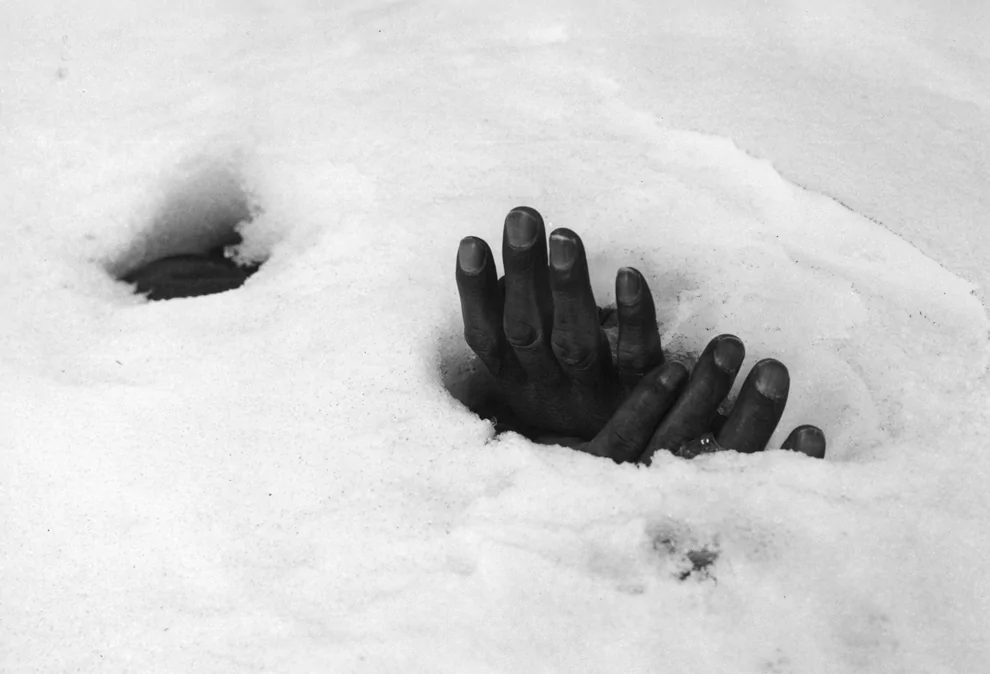
33
A pair of bound hands and a breathing hole in the snow at Yangji, Korea, Jan. 27, 1951 reveal the presence of the body of a Korean civilian shot and left to die by retreating Communists during the Korean War. (AP Photo/Max Desfor) #
1951年1月27日,在朝鮮半島洋吉(Yangji),被縛的一雙手穿過雪地中的透氣孔,雪下之人被撤退中的共軍擊倒,奄奄一息。(美聯社/ Max Desfor)

34
Canadian riflemen catch up on the hometown news while waiting for orders to move up against the Chinese communist forces on the Korean front on Feb. 29, 1951. (AP Photo) #
1951年2月29日,加拿大的步槍手們一邊閱讀家鄉的報紙一邊等着前進的指令,他們將在朝鮮戰場上迎戰中共的軍隊。(美聯社照片)
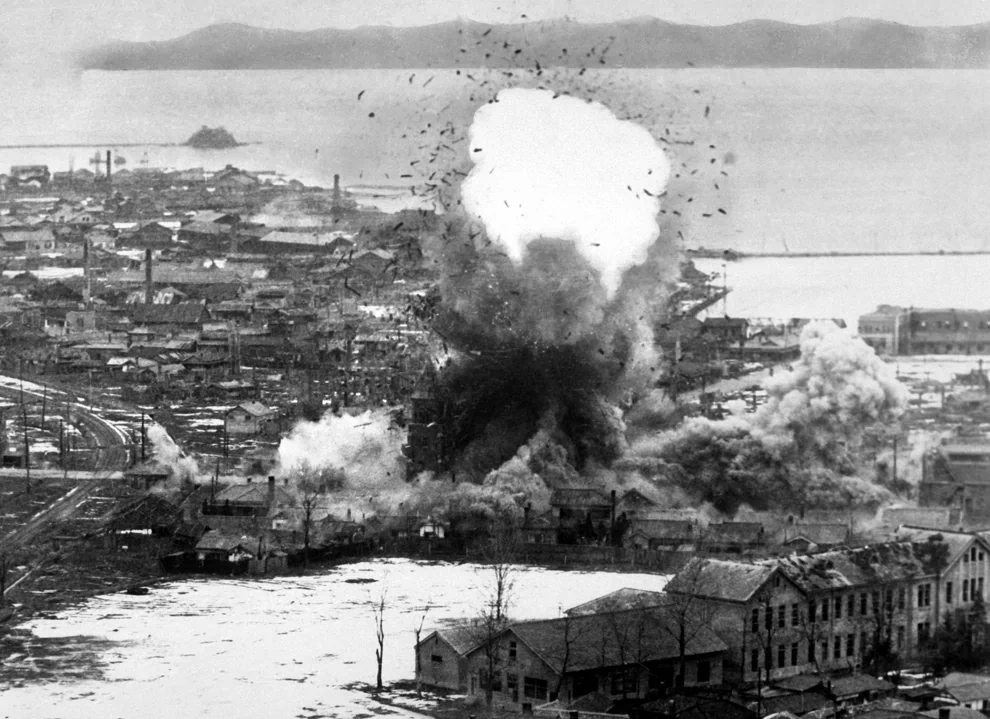
35
Supply warehouses and dock facilities at this important east coast port feel the destructive weight of bombs dropped from Fifth Air Force's B-26 Invader light bombers, Wonsan, North Korea in 1951. (U.S. Department of Defense/USIA) #
1951年在北朝的重要東部港口城市元山,地面的貨物倉庫和碼頭設施遭到美第5軍B-26輕型轟炸機的毀滅性攻擊。(美國國防部/ 美國新聞署)
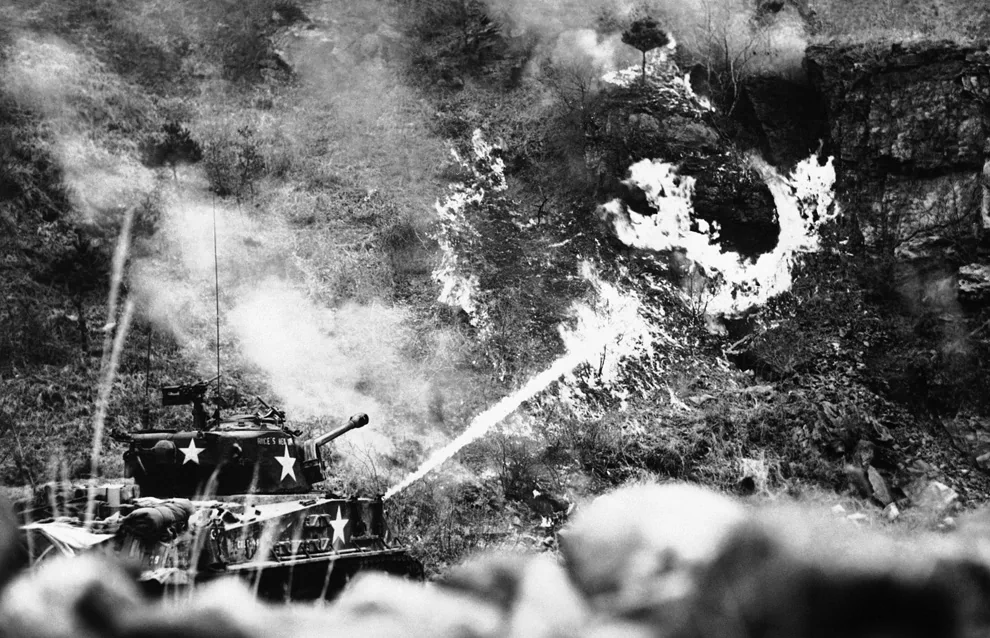
36
A 25th Division tank uses a flame thrower on an enemy pillbox deeply emplaced in a hillside near Korea's Han River front on March 30, 1951. (AP Photo) #
1951年3月30日,美軍第25師的坦克用噴火器攻擊深藏於朝鮮漢江旁山中的敵方碉堡。(美聯社照片)
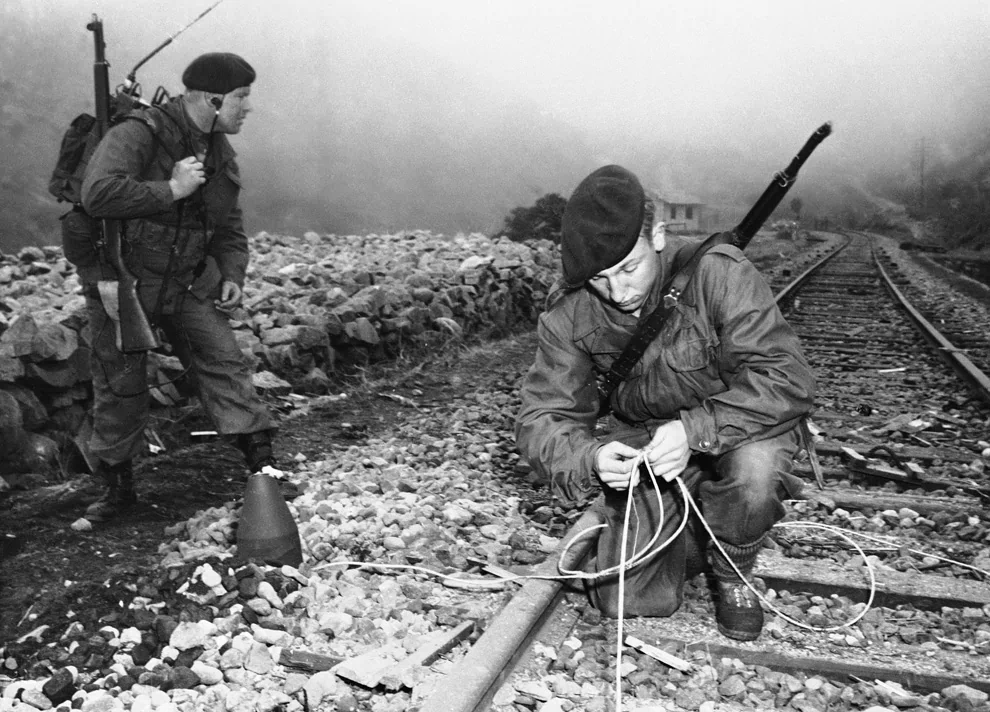
37
British Royal Marines Commandos, put ashore by a U.S. naval vessel deep in the heart of North Korea, plant demolition charges along an enemy rail track on April 13, 1951 near Songjin, South Korea during a daring daylight raid. About 100 yards of the vital Chinese Communist rail line were destroyed within a few miles of two enemy divisions. (AP Photo) #
1951年4月13日,由美國海軍幫助在北韓腹地登陸的英國皇家海軍陸戰隊突擊隊,在金策(Songjin)附近沿敵方鐵軌布下破壞性炸藥包。中共兩個師駐紮地之間約100碼的重要鐵路被破壞。(美聯社照片)
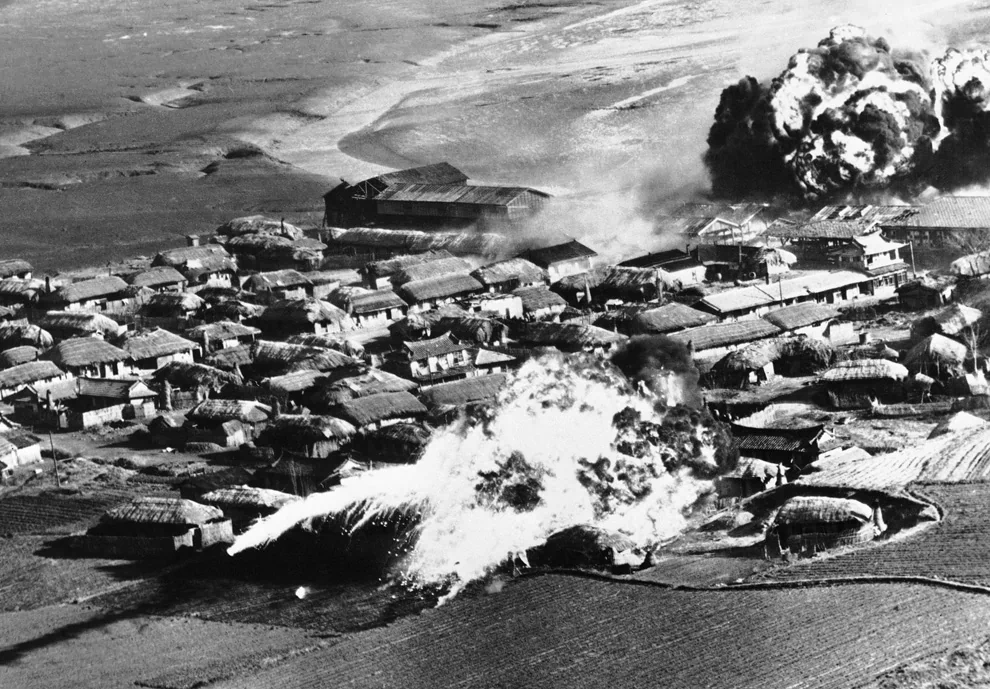
38
Thatched huts go up in flames after B-26 bombers unload napalm bombs on an enemy supply collection point near Hanchon in North Korea on May 10, 1951. (AP Photo) #
1951年5月10日,在北韓的韓川一個補給站附近,B-26轟炸機的一輪凝固汽油彈轟炸後,地面成片茅草屋紛紛着火(美聯社照片)
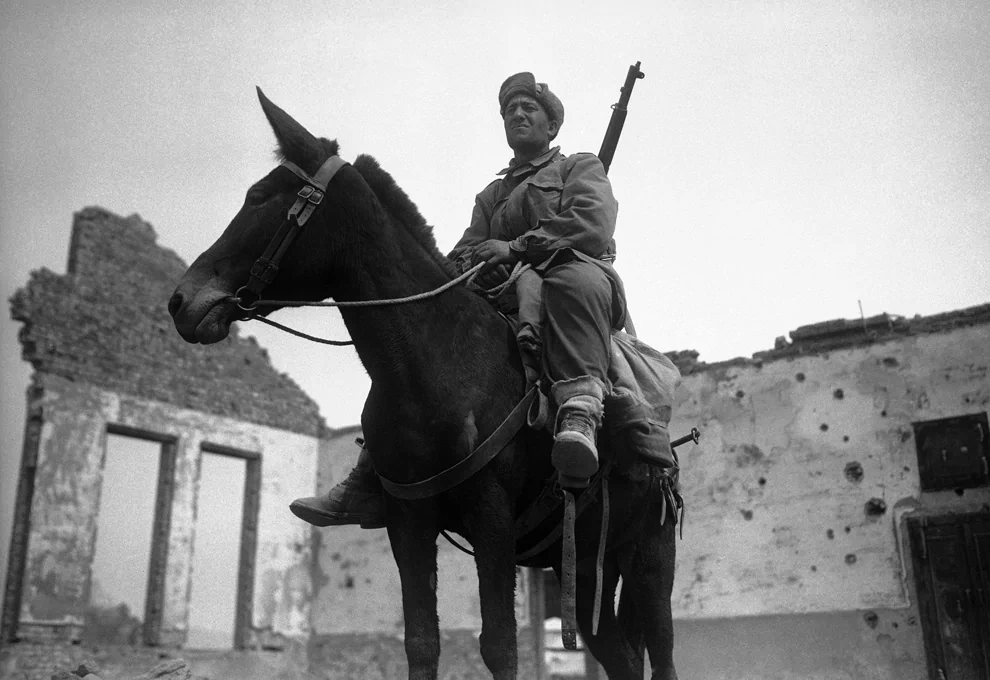
39
Wearied by long marches on foot, a Turkish U.N. solider sits astride a mule he took from an enemy soldier in Korea on May 5, 1951. He ambushed the advancing Chinese and grabbed the mule for use in directing stragglers to the rear in ruins of Uijongbu during the recent communist offensive. (AP Photo/Robert Schutz) #
1951年5月5日,一名聯合國的土耳其戰士長途跋涉後坐在一匹從敵軍那裏繳來的騾子上。在中共軍隊前進途中,他伏擊俘獲了這頭騾子,引導在剛過去的中共軍攻擊後掉隊的己方士兵們轉移到廢墟的後面。(美聯社照片/ Robert Schutz)
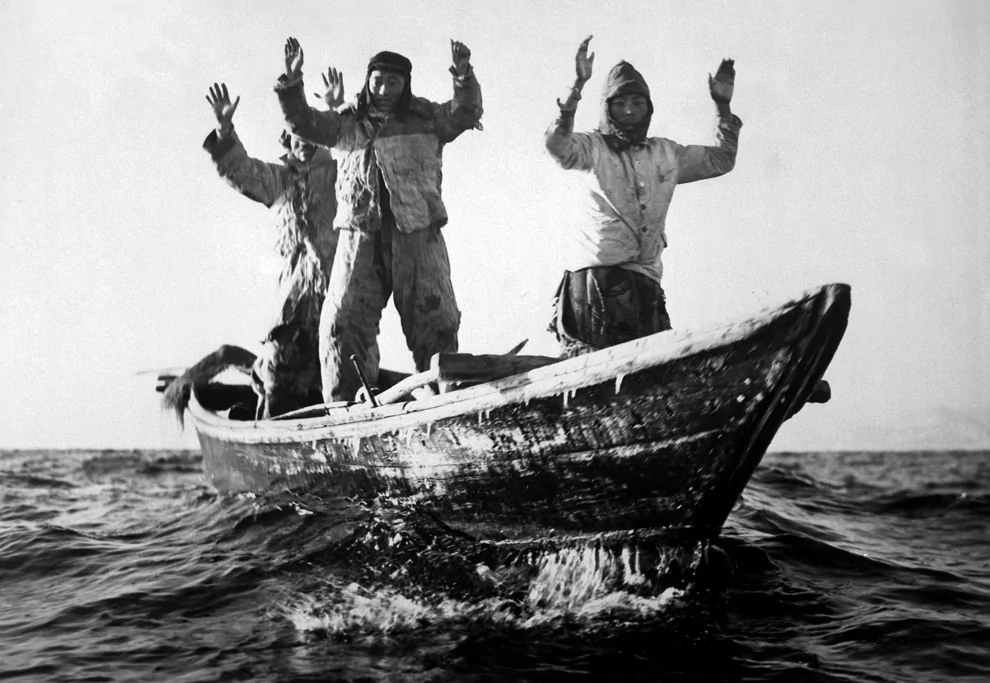
40
Three Korean Communists in a fishing boat are captured by the USS Manchester off the coast of Korea. May 10, 1951. (U.S. Department of Defense/U.S. Navy) #
1951年5月10日,漁船上的3名朝鮮共產黨員成了曼徹斯特驅逐艦的俘虜。(美國國防部/ 美國海軍)
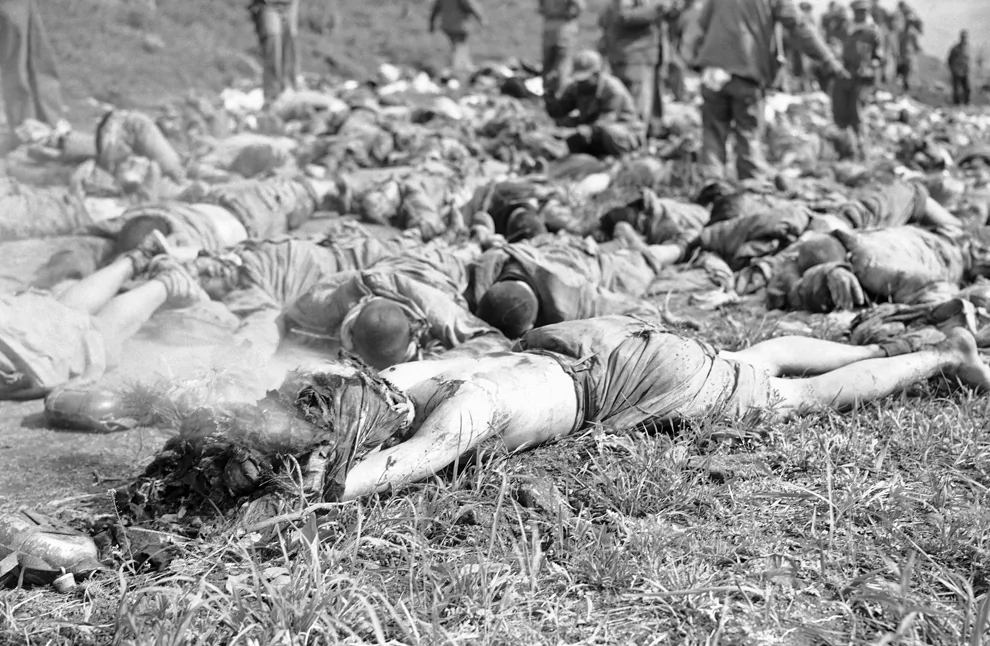
Warning:
This image contains graphic
or objectionable content
click here to view it.
41
A dead Chinese soldier, his burned uniform still smoking, lies with bodies of his comrades at a collection point near Chunchon on May 17, 1951 after allied forces had stemmed the major enemy attack near the town on Korea's central front. (AP Photo/ENJ) #
1951年5月17日,在春川附近的據點,聯軍在朝鮮中部的戰線阻止了一次敵軍進攻。這次戰鬥後,一位剛死去的中共軍人衣衫仍在燃燒,旁邊是他的同志們的屍體。(美聯社照片/ ENJ)
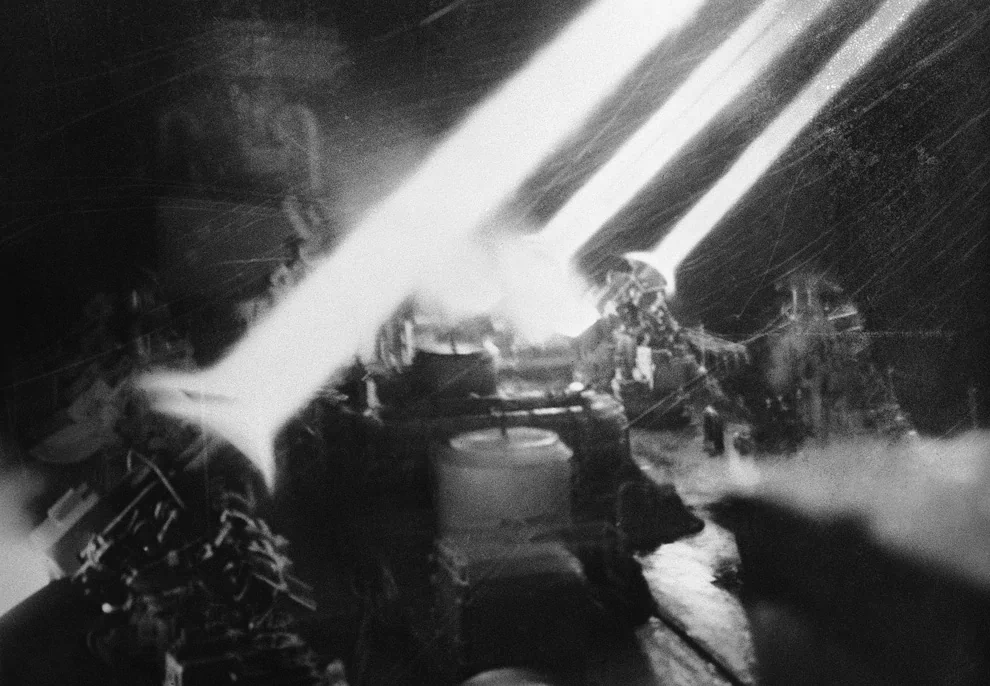
42
Columns of light stab the night as U.S. rockets thunder toward Communist-held targets in Wonsan, Korean port city on July 1, 1951. The fire trails brilliantly lit the ship and could be followed by sight as they struck their targets. (AP Photo/DOD) #
1951年7月1日,光柱刺穿黑夜,美軍火箭朝向共軍在朝鮮港口城市元山的一處目標。火箭的尾跡正好照亮船隻,它們在襲擊目標時可以用肉眼觀察到。(美聯社照片/ 美國國防部)
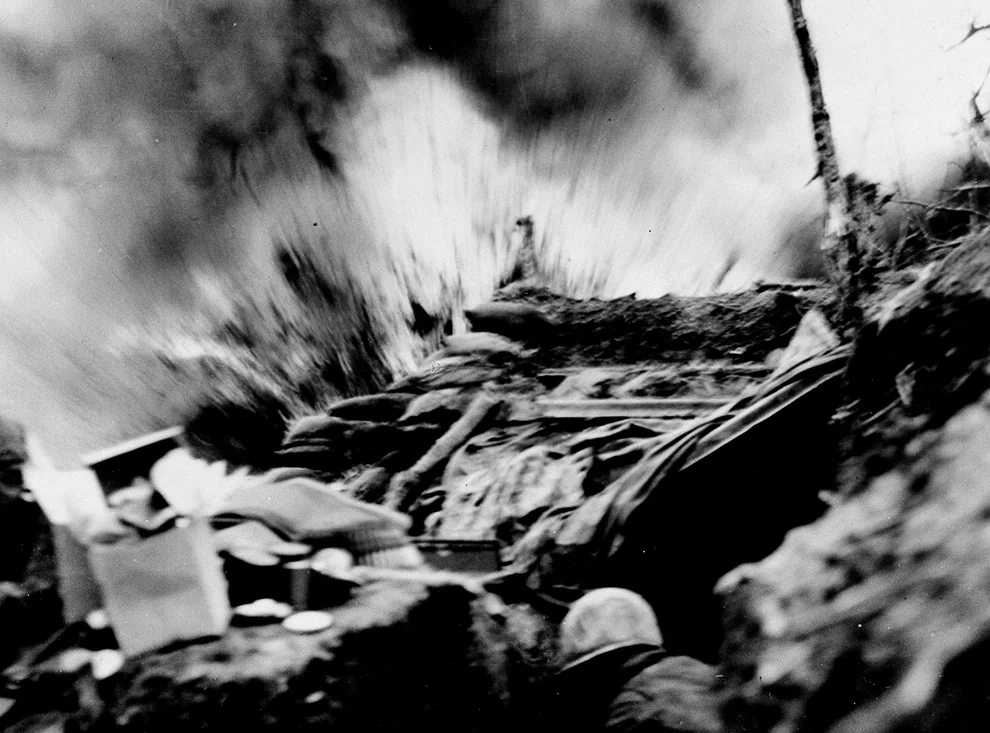
43
A U.S. Marine dives for cover in his bunker as a communist 82 millimeter mortar shell scores a hit on a ridge in eastern Korea, April 8, 1952. (AP Photo/Edward A. McDade/U.S. Navy) #
1952年4月8日,在朝鮮東部,一名美國海軍陸戰隊士兵從碉堡中縱身一躍,躲開了即將墜向山坡上的共軍82毫米迫擊炮彈殼。(美聯社照片/ Edward A. McDade/ 美國海軍)
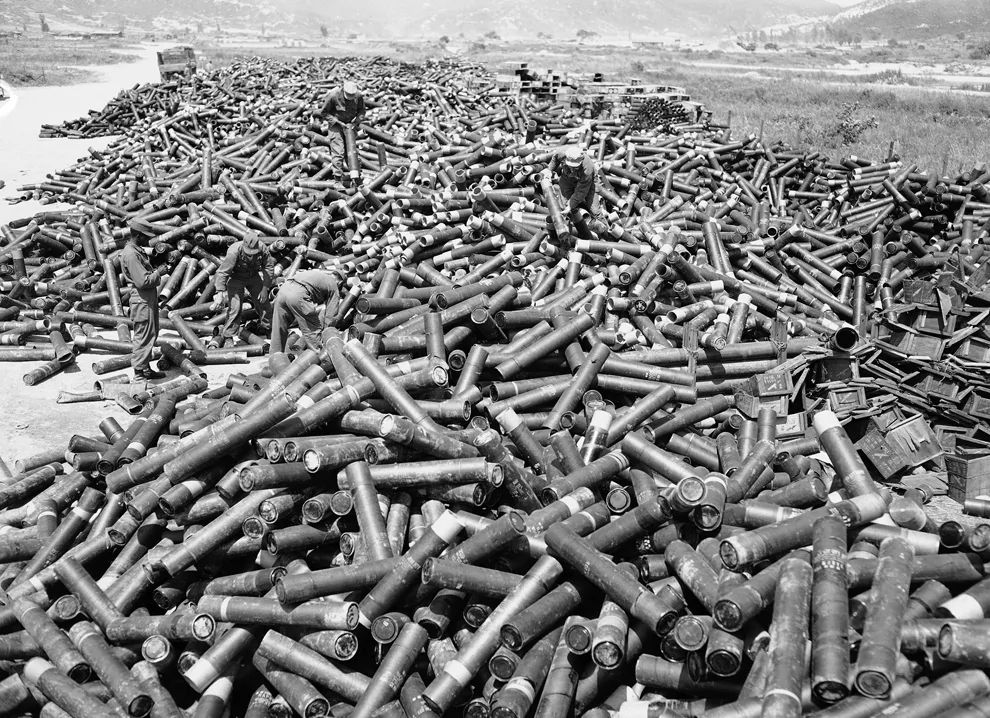
44
GIs and Korean service corpsmen stack up the enormous pile of empty artillery and mortar shell casings at a collecting point near the front, pointing to the huge amount of lead thrown at the enemy in four days of fighting for outpost Harry, June 18, 1953. (AP Photo/Gene Smith) #
1953年1月18日,美國兵和韓國的服役人員將火炮和迫擊炮的空彈殼壘在一處集中地,這些彈藥是在為拿下鐵三角地的4天中攻擊所消耗的。(美聯社照片/ Gene Smith)
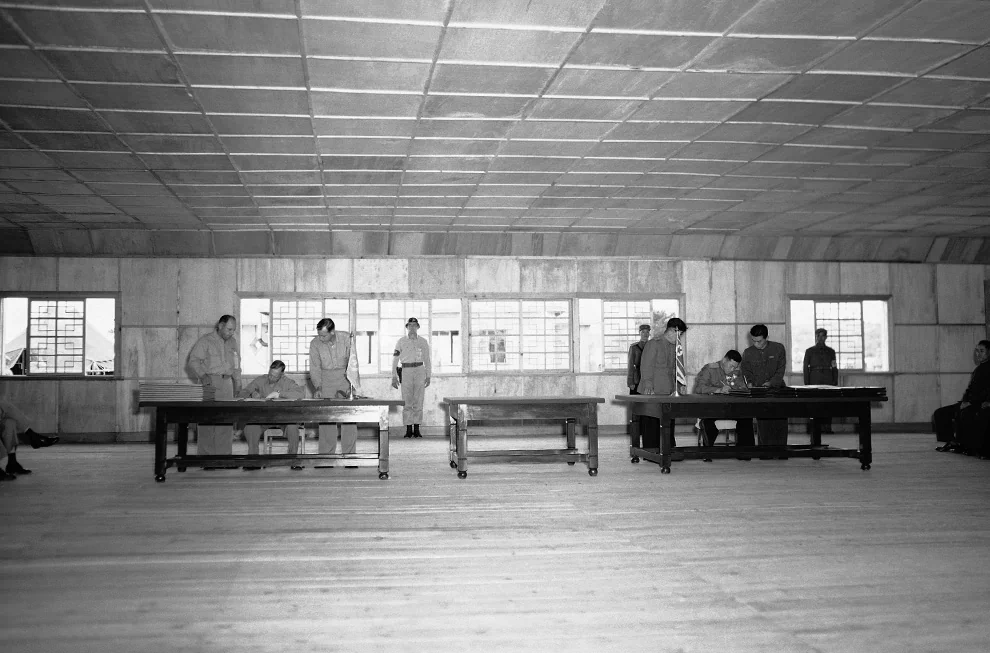
45
The interior of Bruce house - General William K. Harrison (left) and General Nam II (right) sign the armistice agreement which brought the Korean War to a close in Panmunjom on July 27, 1953. (AP Photo) #
1953年7月27日,在板門店,William K. Harrison上將(圖左)和Nam II上將(圖右)簽署了韓戰的停火協議。(美聯社照片)
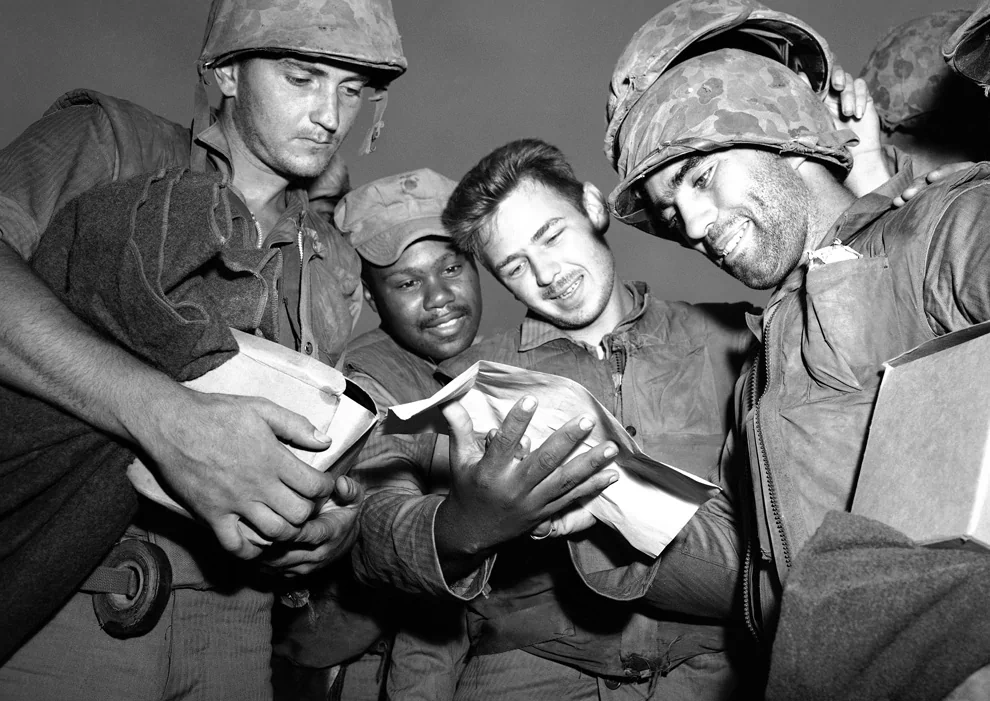
46
Four tired, bearded and grimy U.S. Marines just off the fighting line on western Korean front, read good news in an official handout that armistice to end war was about to be signed at Panmunjom on July 26, 1953. Identifiable at right is PFC Thomas W. O'Connell of Hammond, Wisconsin. (AP Photo/George Sweers) #
1953年7月,美國海軍陸戰隊的4名剛從朝鮮西部鋒線上歸來的戰士,鬍子拉碴、疲憊不堪、滿身塵土。他們讀着官方材料里的新聞,了解到停火協議就要在26日簽署了。圖中右手的是威斯康星州哈蒙德的一等兵 Thomas W. O'Connell。(美聯社照片/ George Sweers)
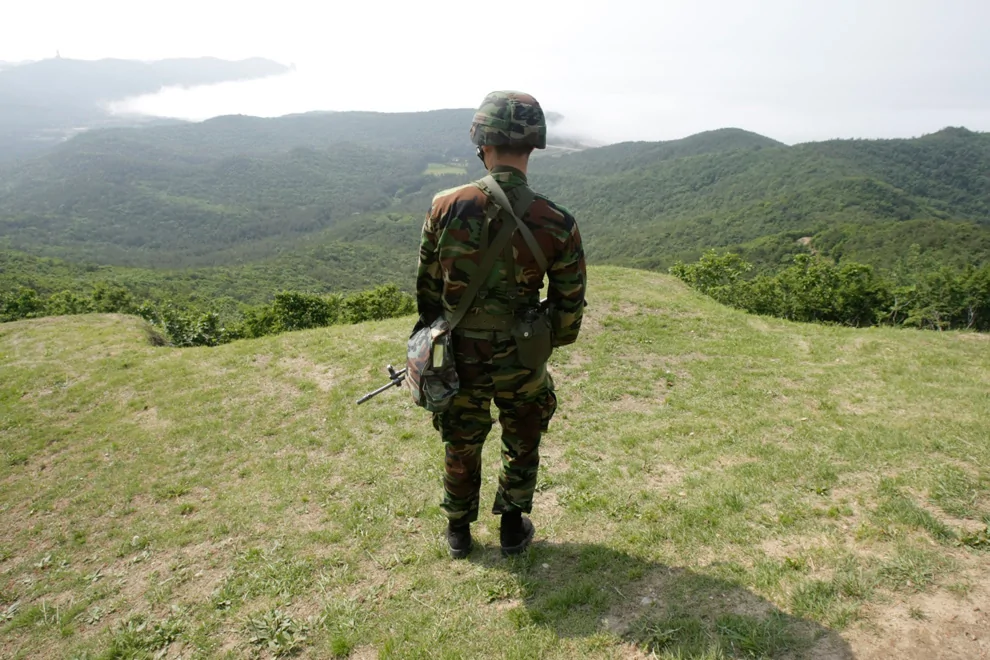
47
In this photo taken on Tuesday, June 15, 2010, a South Korean Marine looks at the North Korean side as he stands guard on Baengnyeong Island, South Korea, near the border with North Korea. (AP Photo/Ahn Young-joon) #
2010年6月15日,周二,一名韓國海軍陸戰隊士兵在白翎島站崗,眼望韓朝邊境。(美聯社照片/ Ahn Young-joon)
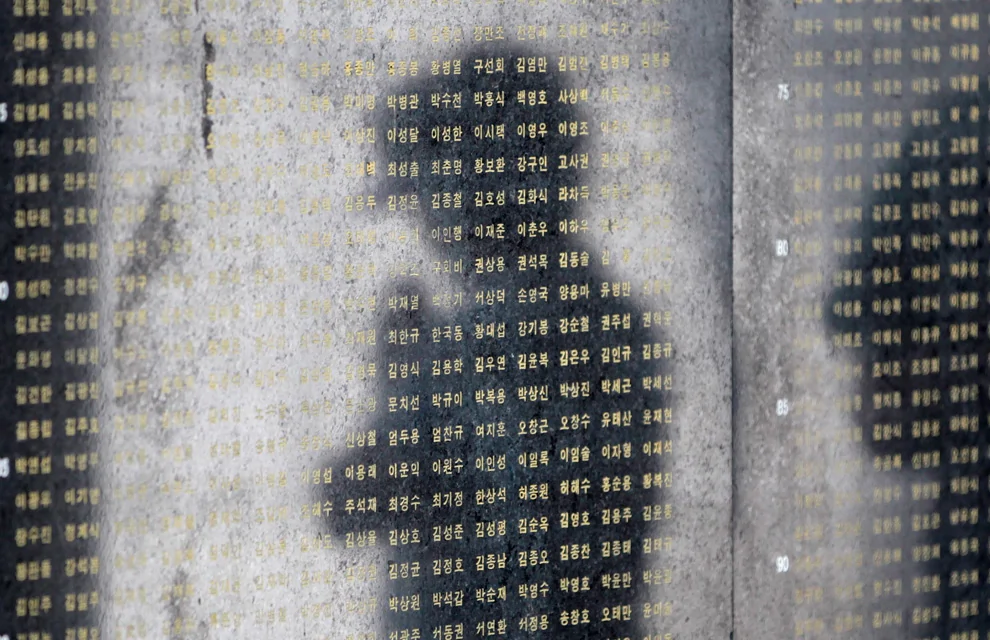
48
A woman is reflected on the names of the people who died during the 1950-53 Korean War as she prays for the fallen sailors from the sunken South Korean naval ship Cheonan at the Korean War Memorial Museum in Seoul June 20, 2010. (REUTERS/Jo Yong-Hak) # 2010年6月20日,在韓國首爾的韓戰紀念館裏,一位女士為韓國海軍天安艦沉海時喪生的水手祈禱。她的身影掩映在韓戰犧牲戰士的紀念碑上。(路透社/ Jo Yong-Hak)


















